Dropshipping on Shopify vs Amazon FBA in 2024 [Expert Advice]
Torn between Amazon vs Shopify for your dropshipping venture? Wondering which platform will lead to success in 2024?
This expert-backed article breaks down the key differences, pros, and cons of both, helping you uncover the ideal solution for your ecommerce business.
From autonomy to ease of use, explore the hidden strengths of these platforms and gain valuable insights on which one can skyrocket your online sales!
Table of Contents
- Key Takeaways
- What Is Shopify?
- What is Amazon FBA?
- The No. 1 Tool for all dropshippers – now with AI
- What Are The Differences – Amazon vs Shopify for Dropshipping?
- Amazon vs Shopify – My In-Depth Comparison
- Amazon vs Shopify – Pros & Cons
- Can You Use Both Amazon and Shopify for Dropshipping?
- How To Start Dropshipping From Amazon To Shopify in 2024? (Step-By-Step)
- Amazon Vs Shopify Real-Life Success Stories & Expert Advice
- Teen Entrepreneur Alex Philip: How a Young Dropshipper Built a Multi-Million Dollar Empire
- From 9-to-5 to Millionaire: How Mina Elias Turned Amazon FBA Into a Multi-Million Dollar Success
- Alex Ikonn & Mimi: Building a Seven-Figure Empire with Luxy Hair
- Andreas & Alexander: Achieving $10 Million in Pet Dropshipping Sales
- Amazon vs Shopify – Who Wins?
Key Takeaways
| Feature | Shopify | Amazon FBA | Winner |
|---|---|---|---|
| Ease of Use | Beginner-friendly, drag-and-drop editor | More complex setup, requires optimization | Shopify |
| Autonomy | Full control over branding and store design | Limited customization, shared platform | Shopify |
| Design & Customization | Highly customizable, over 140 themes | Limited to Amazon templates, branding restrictions | Shopify |
| Features | Over 450 dropshipping apps, customizable themes | Access to global marketplace, Amazon Prime shipping | Tie |
| Dropshipping Capabilities | Extensive app integrations, full control over store | Possible, but limited by Amazon’s seller restrictions | Shopify |
| Pricing | Starts at $32/month + transaction fees | $39.99/month for Pro sellers + referral and FBA fees | Shopify |
| Payment Methods | Multiple options: Shopify Payments, PayPal, Apple Pay, Google Pay | Credit/debit cards, Amazon Pay | Shopify |
| Shipping Options | Integrated with USPS, UPS, DHL, third-party fulfillment | FBA: Amazon handles all logistics | Amazon FBA |
| Analytics | Detailed analytics, customer insights, advanced reporting | Limited analytics for individual sellers | Shopify |
| SEO & Marketing | Built-in SEO tools, social media integrations, blogs | Amazon algorithm boosts visibility, built-in traffic | Shopify |
What Is Shopify?

Shopify is a robust and user-friendly ecommerce platform and the best website builder I’ve ever used! It empowers online business owners to create and manage their own online stores.
Thus, with its wide range of features and customizable templates, Shopify provides a scalable solution for dropshipping businesses of all sizes.
It offers an extensive marketplace of third-party apps and integrations, a built-in payment processor, customizable templates, and much more.
Read about Is Shopify Legit in 2024? +6 Common Shopify Scams.
What is Amazon FBA?
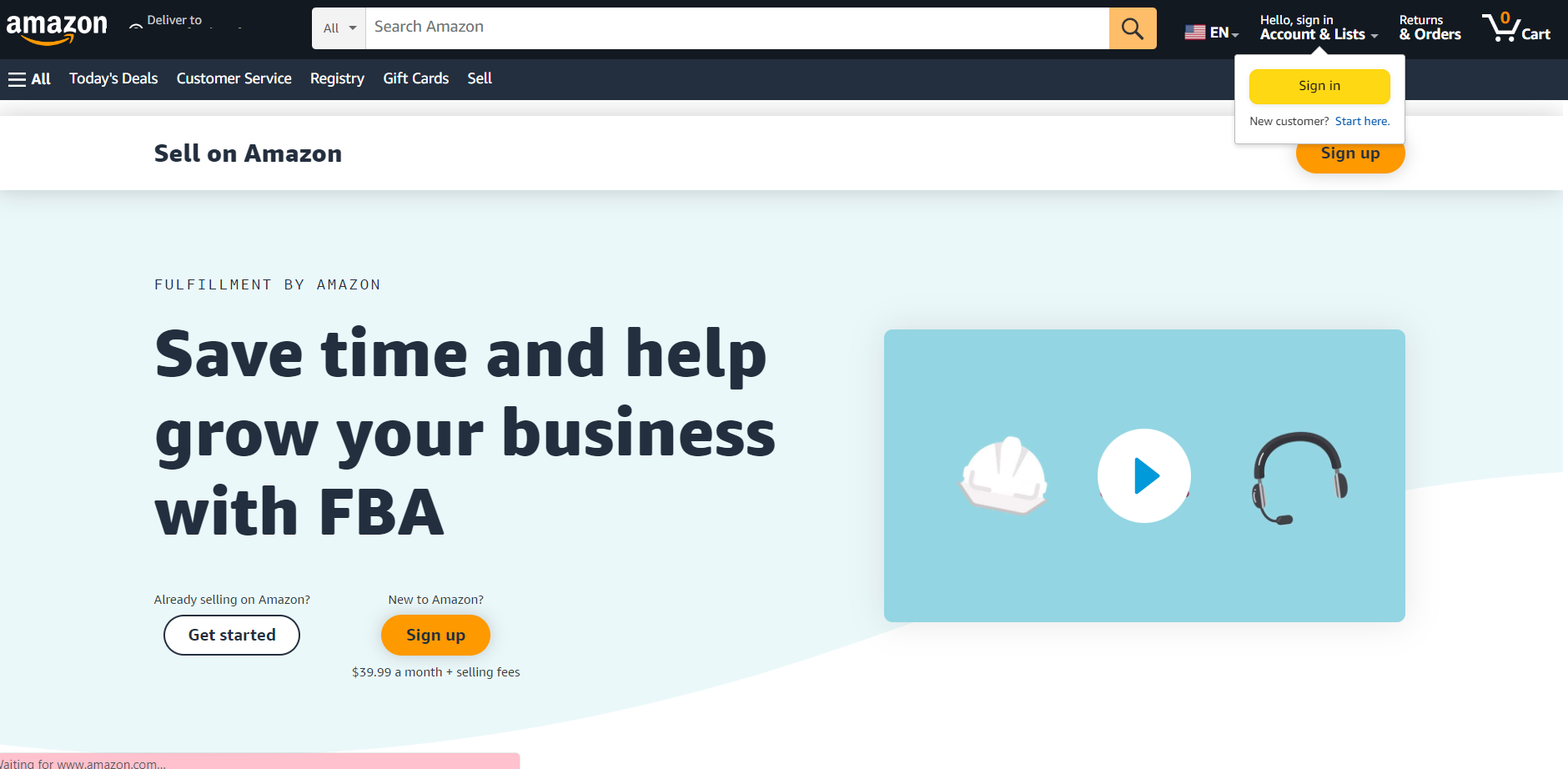
Amazon FBA, or Fulfillment by Amazon, is an e-commerce service provided by Amazon that offers a variety of benefits for online sellers.
So, while Shopify is an ecommerce platform that allows business owners to create and customize their own online stores, Amazon FBA takes a different approach by offering a ready-made customer base and a comprehensive fulfillment solution.
With Amazon FBA, you can store your inventory in Amazon’s fulfillment centers. This means that Amazon takes care of storing, packing, and shipping the products on behalf of the seller. Plus, you have access to Amazon’s vast customer base.
💡 Tip: Discover the 17 Best Multi Vendor Marketplace Platforms For Ecommerce.
Now, let’s see the main differences between Amazon vs Shopify.👇
👉 Learn How To Become An Amazon Product Tester From Home.
What Are The Differences – Amazon vs Shopify for Dropshipping?
If you want to make money, both platforms are a great option. Both the platforms offer tools you can use but they aren’t exactly the same. They both operate in their own ways.
Shopify is a unique e-commerce platform that gives you the needed tools and designs to build your own dropshipping website.
Amazon is not exactly that, Amazon is more about letting you use their website with other sellers to make a profit.
You can imagine it this way, Amazon would be just like if you used someone’s office to do business. Whatever you do, you can’t really promote yourself as much. It is more of an office with individual sellers and not a team.
Shopify is just like renting a building and doing business there. You don’t owe the building but you can promote yourself as much as you want. You have your own store, maybe even a team, and can do anything you want.
Amazon vs Shopify – My In-Depth Comparison
🔸 Ease of use
When it comes to ease of use in selling online, both Shopify and Amazon offer user-friendly interfaces that cater to different needs.
➡ Shopify is renowned for its intuitive and beginner-friendly platform. With a straightforward setup process, users can easily create and customize their online stores using pre-existing templates and themes.
They have an easy navigational dashboard from which you can access their drag-and-drop editor and customize your store quickly and hassle-free. Plus, you can manage your order fulfillment, inventory, products, and more.
➡ On the other hand, Amazon provides you with access to a global marketplace with an already-established customer base.
While the setup process on Amazon can be slightly more complex compared to Shopify, it has various steps before you sign up, and it requires lots of serious information.
Plus, their dashboard looks more complex, with lots of information on it. Hence, for beginners, it can be a little bit confusing.
Also, the competition is fierce on Amazon, and you need to optimize your product listings, pricing, and fulfillment methods to stand out from the crowd.
In my opinion, Shopify excels in ease of use and customization options, while Amazon offers access to a massive global marketplace but with stiffer competition.
🔸 Autonomy
Without a doubt, Shopify is the winner here. Since you own your own e-commerce store, that also means you have autonomy.
➡ As long as you pay your monthly fees, your autonomy on Shopify will always belong to you without any external interference. And, you have full hands of self-control here, whether is your store design, products you are selling, apps you are using, etc.
➡ Amazon on the other hand as I mentioned before doesn’t have much autonomy here. Thus, you aren’t using your own website or designing it according to your preferences. The only thing you have control of is your product.
🔸 Key Features
Now, let’s take a closer look at the Amazon vs Shopify features.
➡ Shopify Features
Shopify boasts a range of features designed to simplify the process of setting up and managing an online store.
First things first, their drag-and-drop editor allows you to make stunning and unique landing pages. This way, you can build your brand and stand off the crowd. What’s more, it offers you 140+ paid and free templates to choose from. And, you can change everything there as well!
Shopify also offers a wide range of ecommerce tools at their Shopify app store, including product listings, inventory management, and order tracking. In fact, I think that at this moment there are over 450 apps designed just for dropshippers.
Additionally, it provides integration with social media channels, apps, and platforms, allowing you to reach a broader audience.
👉 Learn How To Set Up Your First Store On Shopify [No.1 Beginners Guide].
➡ Amazon Features
On the other hand, Amazon offers a robust online marketplace with a vast customer base. So, if you are looking to expand your sales faster, this might be your solution.
However, it does not offer a unique storefront, like Shopify. So, it is very challenging to attract customers to your store, since it is not different than your competitors.
The best part, Amazon also facilitates the fulfillment process through its FBA service, streamlining shipping and order processing. It allows you to outsource your warehousing, order fulfillment, and shipping processes.
Plus, they personally take care of all aspects of the logistics, including picking, packing, shipping, and customer service. Plus, from your inventory management dashboard, you have full control over inventory.
Hence, you can create shipping plans, send in shipments, track and monitor your shipments, and remove inventory from Amazon fulfillment centers.
Another significant feature of using Amazon FBA is the ability to offer Prime shipping to customers. Thus, you can tap into this feature and attract more customers who prioritize fast and reliable delivery. This can lead to higher conversion rates and increased customer loyalty.
Also, they offer a wide range of tools to help you plan, automate, outsource, scale, and keep your business humming.
However, I use Ecom Authority for my Amazon store and it has revolutionized the way I do business.
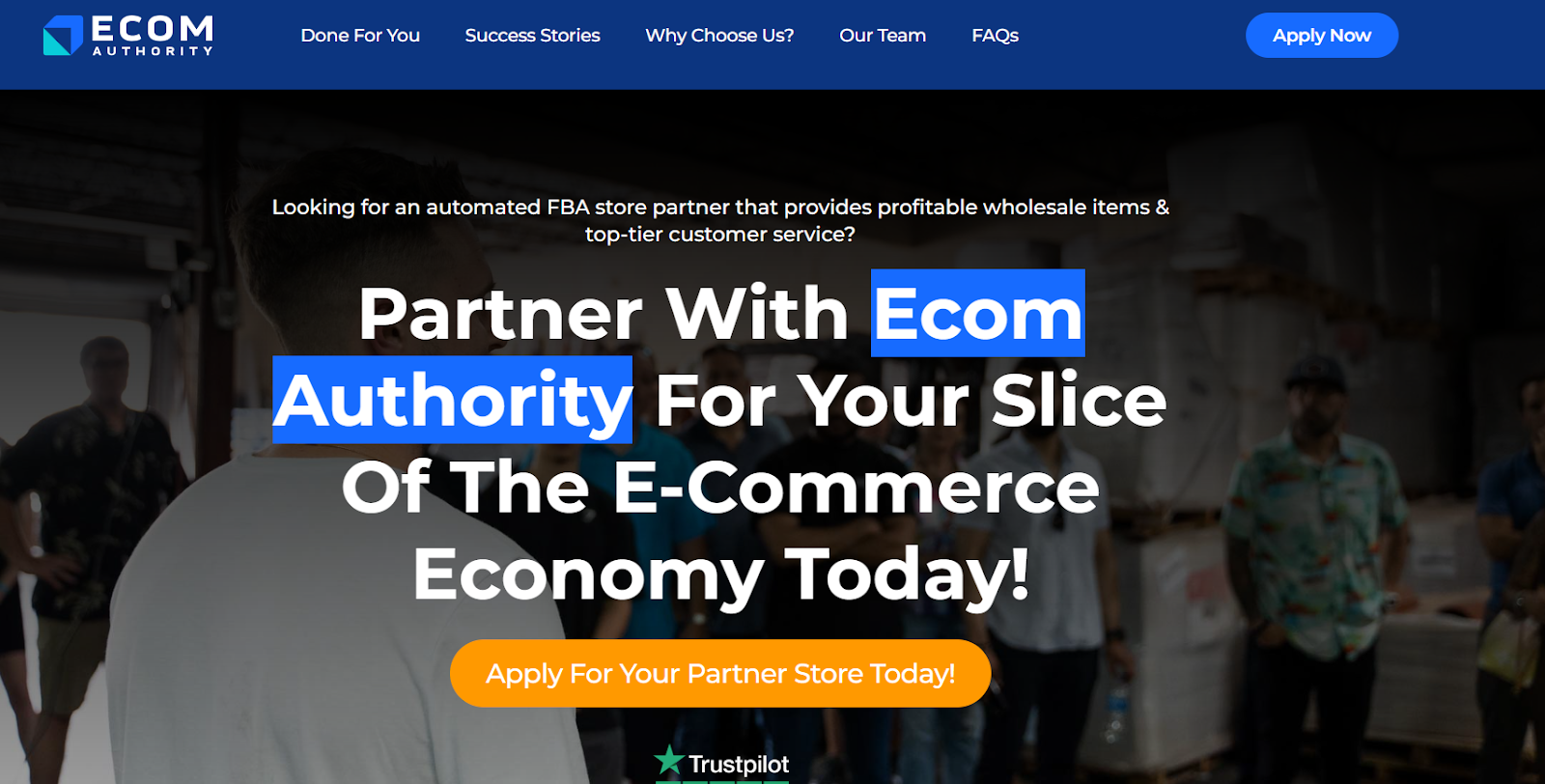
This tool manages everything, from the initial setup to daily tasks, allowing me to focus on growth and strategy.
Furthermore, Amazon allows users to search for a wide range of products based on keywords, categories, or specific criteria. But, remember, you must do research on whether you deal with reliable dropshipping suppliers.
Next, you can create detailed product listings that include descriptions, images, pricing, and other relevant information to attract potential buyers.
👉 Check out the 20 Best Dropshipping Suppliers For Amazon In 2024.
🔸 Design & Customization
➡ Shopify Design & Customization
With Shopify, you’re in charge of the look and feel of your own online store. You don’t need to be a designer either – Shopify provides over 215 free and paid themes to choose from, giving you a great starting point to customize your online store.
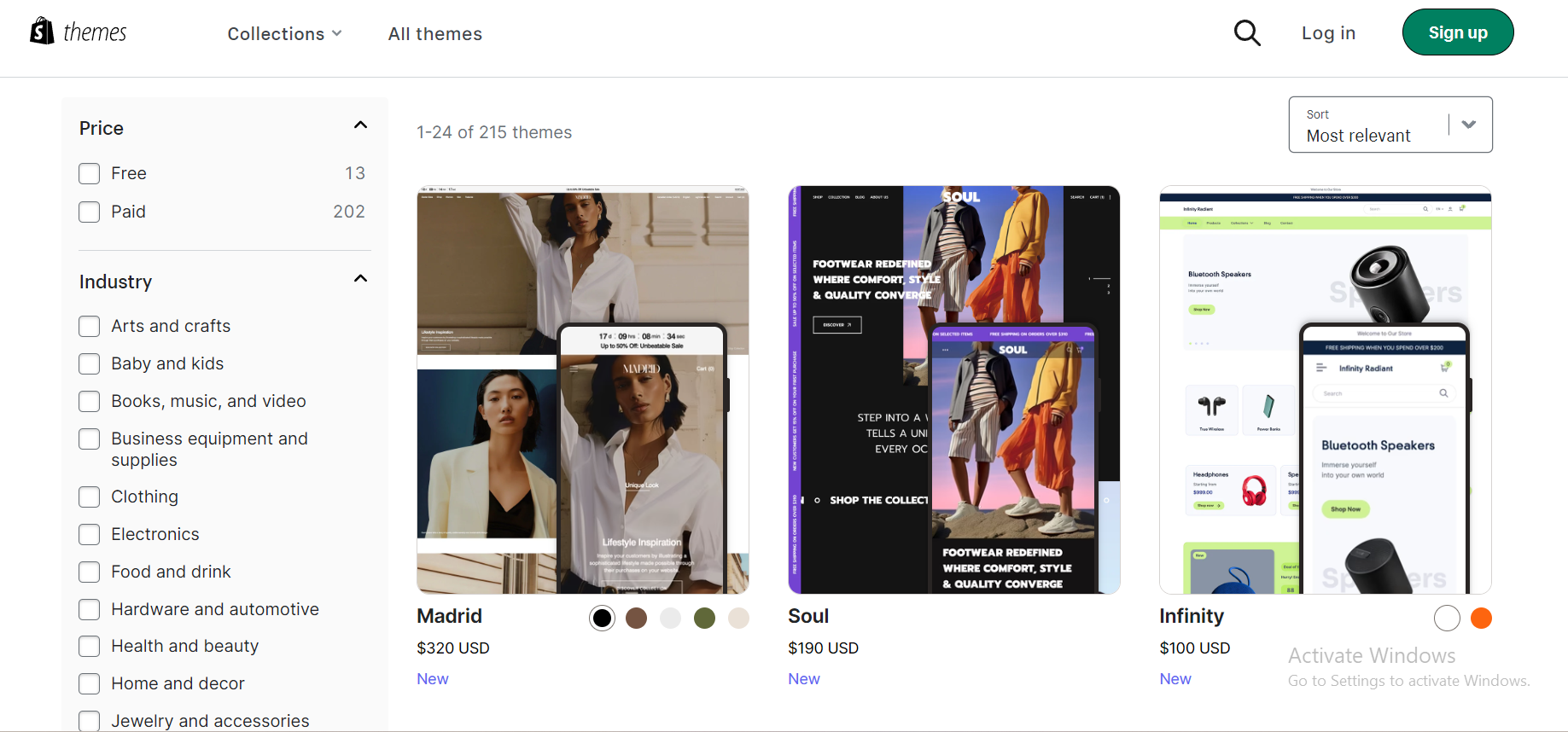
Whether you’re selling t-shirts or any other product, you can tailor your Shopify store to fit your brand’s unique style.
For example, if you run an ecommerce business selling apparel, you could use a theme with bold visuals and adjust the colors, fonts, and layout to highlight your products.
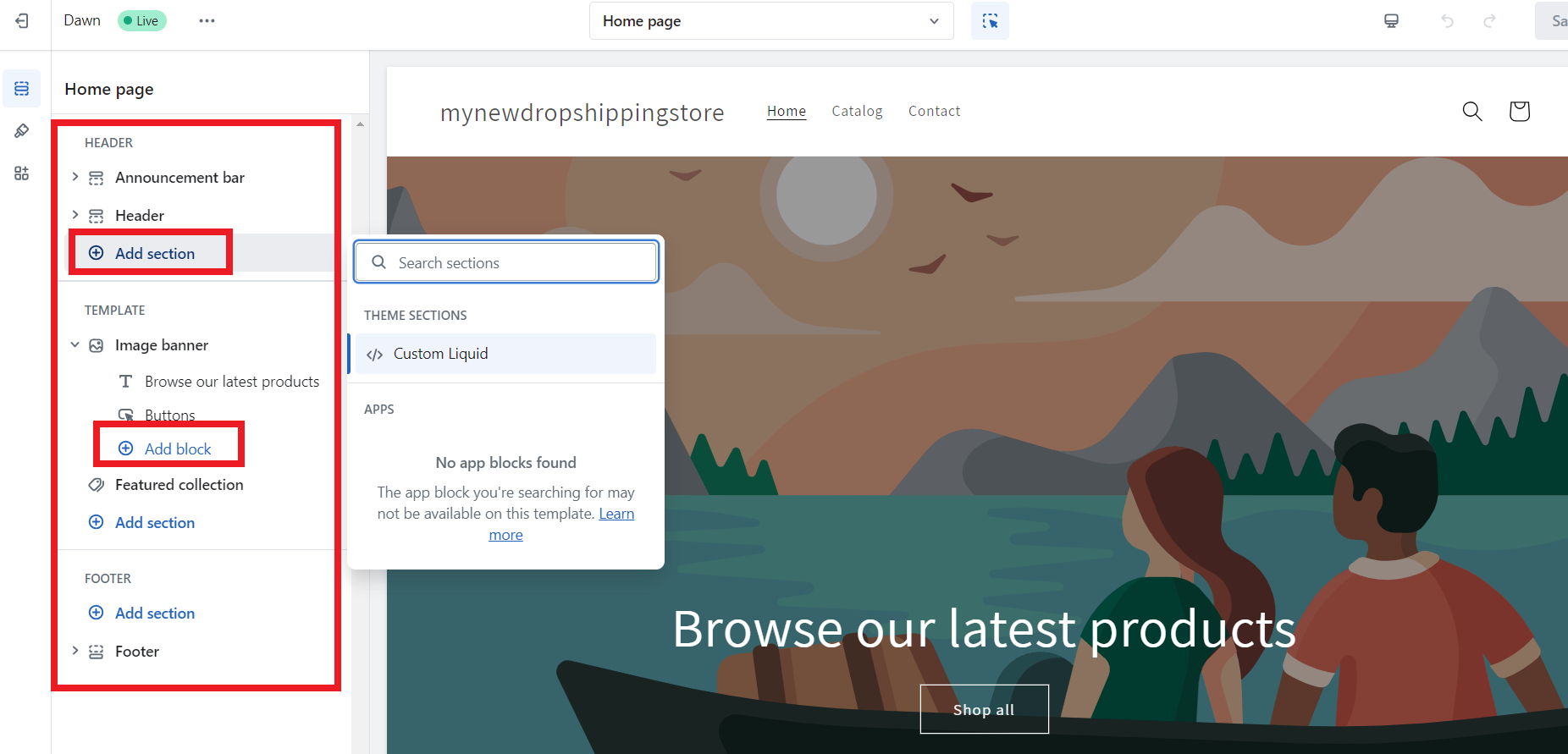
Shopify offers 13 free themes and over 200 premium ones, ranging from $170 to $380. These themes are optimized for online stores, helping you capture the attention of online shoppers.
If you’re using additional features like Shopify Payments or the Shopify App Store, you can further enhance your store with discount codes, shipping settings, and more. Shopify’s flexibility in design is why it consistently ranks high when compared to other ecommerce platforms like Squarespace.
Plus, since Shopify lets you switch themes and continue tweaking as your ecommerce platform grows, it’s a perfect choice for any online business looking to scale.
➡ Amazon Design & Customization
While Shopify offers flexibility, Amazon works differently. When selling on the Amazon marketplace, all store pages have a similar layout.
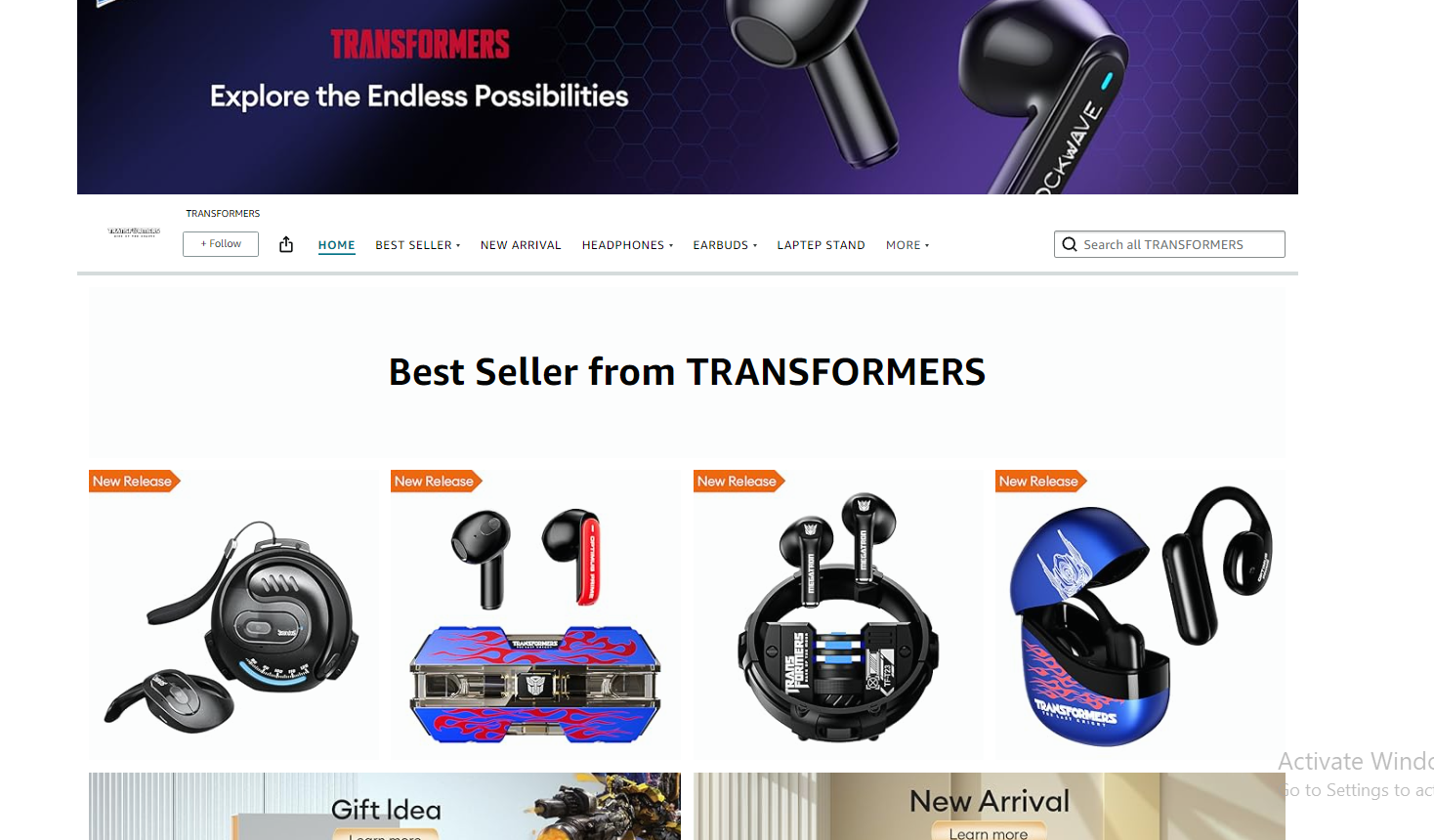
You can add your own images and descriptions, but the overall design is very much Amazon’s.

This uniformity can make it harder for Amazon sellers to make their brand stand out. Your products are featured alongside competitors, which may increase sales, but makes it tough to create a distinct brand image.
However, Amazon offers the option to build a brand storefront for professional sellers or those using Amazon FBA. Here, you can create a space tailored to your brand by selecting templates, adding images, and embedding videos.
While you can’t customize as freely as you can with a Shopify store, it still offers more control than standard Amazon seller pages.
Keep in mind that creating a brand storefront requires enrollment in the Amazon Brand Registry or selling directly through Vendor Central.
Though Amazon’s structure makes it hard to fully own your brand like with a standalone online store, its massive reach and built-in customer base through the online marketplace make it a valuable platform for expanding your ecommerce business.
🔸 Amazon vs Shopify Pricing
➡ Shopify Pricing
Shopify offers four pricing options for users.
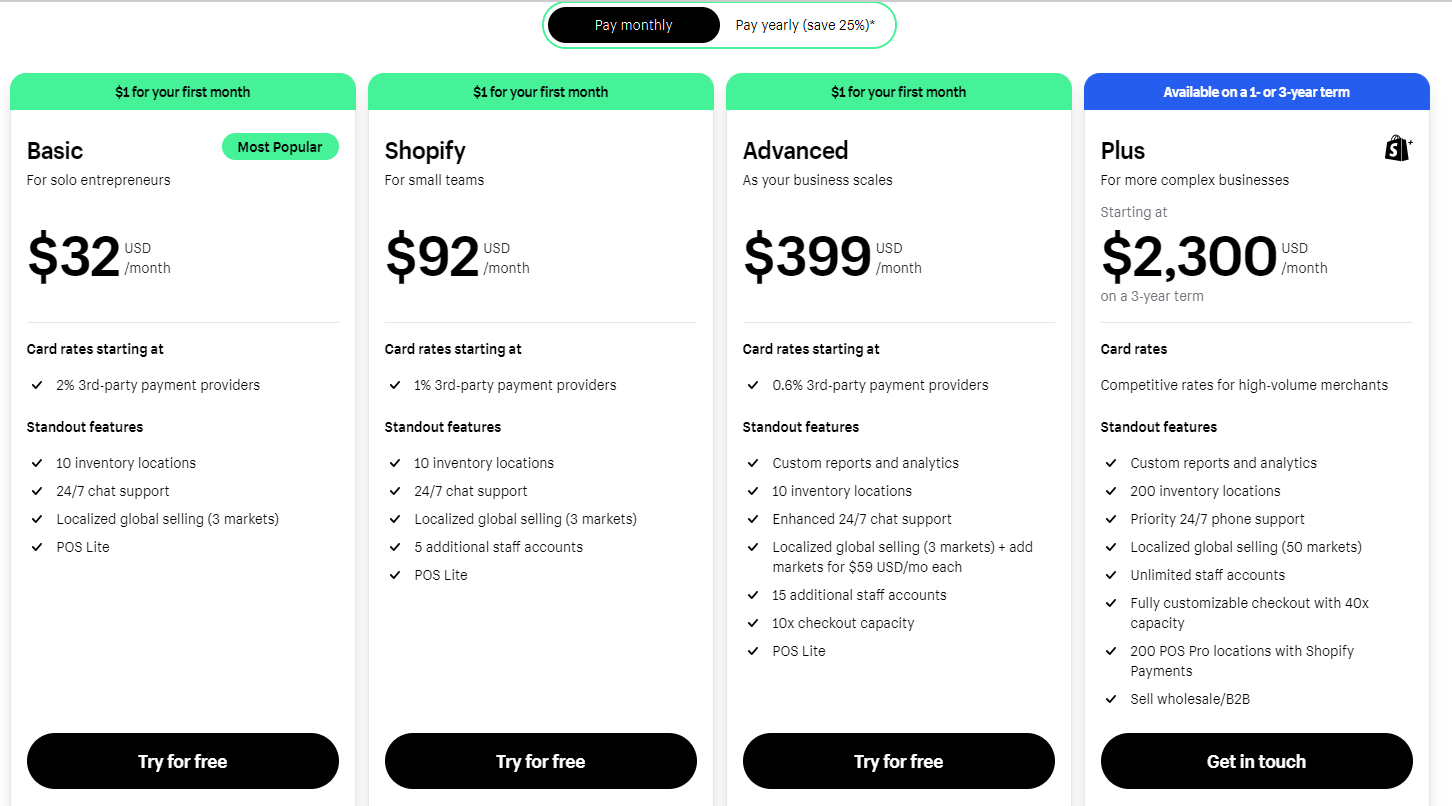
The Shopify Basic package is priced at $32 per month and provides features like unlimited product listings, one staff account, a website and blog, and integration with third-party apps.
The Shopify Regular plan, available for $92 per month, includes all the features of the Basic plan and is tailored for businesses with higher sales volume. It offers additional benefits such as the ability to create up to five staff accounts, advanced report generation, and real-time carrier shipping.
The Advanced Shopify plan, priced at $399 per month, is the most comprehensive option and is suited for businesses with complex needs and substantial sales volume. Alongside the features of the Basic and Regular plans, this package provides advanced features like the ability to create up to 15 staff accounts, advanced report generation, and real-time carrier shipping, duties, and import taxes.
For large-scale enterprises, Shopify Plus is the recommended platform, with a monthly cost of $2,300. This plan includes all the features of the standard Shopify package, along with additional high-volume features specifically designed for larger businesses.
Also, the transaction fees range in addition to the monthly subscription fees that you pay to use the Shopify platform.
- Basic Shopify Plan – charged a transaction fee of 2.9% + 30¢ for each online transaction made.
- Shopify Regular Plan – charged a transaction fee of 2.4% + 30¢ for each online transaction.
- Advanced Shopify Plan – transaction fee of 2.4% + 30¢ for each online transaction.
👉Check out the Shopify Pricing Plans in detail.
➡ Amazon FBA Pricing
First, Amazon offers professional selling plans for sellers who anticipate high sales volume, priced at $39.99 per month, while individual sellers pay $0.99 per item sold.
On the other hand, Amazon charges fees based on a referral model. Sellers on Amazon pay referral fees for each product sold, which vary depending on the product category.
Check out the referral fees for each category here.
It is important to note that Amazon also has additional costs, such as fulfillment fees for storing and shipping products through their fulfillment centers. These fees include charges for storage space, order handling, and pick and pack.
Overall, Shopify’s pricing structure is more straightforward, with fixed monthly fees, while Amazon’s fees depend on the products sold and additional costs like fulfillment fees.
🔸 Payment Methods
Amazon mostly allows credit & debit cards as the main payment methods while Shopify allows any kind of payment method. Let’s see this in more detail.
➡ Amazon Payment Methods
- Credit or Debit Cards. Amazon accepts major credit and debit cards, including Visa, Mastercard, American Express, and Discover.
- Amazon Store Card. This is a credit card issued by Synchrony Bank exclusively for Amazon customers. It offers special financing options and rewards for Amazon purchases.
- Amazon Gift Cards. Customers can use Amazon gift cards to make purchases on the platform. These gift cards can be purchased online or in physical stores.
- Amazon Pay. This is a digital wallet service provided by Amazon that allows customers to make payments using their Amazon account information. It can be used on various websites and apps that accept Amazon Pay.
- Amazon Cash. This is a service that allows customers to add cash to their Amazon account by visiting participating retailers and presenting a barcode. The added cash can then be used for purchases on Amazon.
➡ Shopify Payment Methods
- Shopify Payments. This is Shopify’s built-in payment gateway that allows merchants to accept credit card payments directly on their online store. It supports major credit cards like Visa, Mastercard, American Express, and Discover.
- PayPal. Shopify integrates with PayPal, allowing customers to make payments using their PayPal account. It provides a secure and widely recognized payment option.
- Stripe. Stripe is a popular payment gateway that integrates with Shopify. It allows customers to pay using credit cards and supports various currencies.
- Apple Pay. Shopify supports Apple Pay, enabling customers to make purchases using their Apple devices with a single touch or click.
- Google Pay. Shopify also integrates with Google Pay, allowing customers to make payments using their Google account information.
- Klarna. Klarna is a “buy now, pay later” service that integrates with Shopify. It allows customers to make purchases and pay in installments over time.
- Amazon Pay. Similar to the Amazon Payment method mentioned earlier, Shopify also supports Amazon Pay as a payment option on its platform. Customers can use their Amazon account information to make purchases.
👉 Read about the 7 Best Payment Gateways For Shopify In 2024.
And, my answer is clear on this – Shopify is definitely my winner.
🔸 Integrations
➡ First, Amazon integrates with various tools to support its business, like Amazon Pay, Amazon Seller Center, Amazon Prime, Amazon Web Services (AWS), Amazon Marketplace Web Service (MWS), etc.
Also, it partners with many other popular platforms, like Shopify, Microsoft, Adobe, Red Hat, HubSpot, WooCommerce, and many others.
➡ On the other hand, Shopify offers a wide range of integrations through its App Store, allowing you to add functionalities like email marketing, customer support, and social media management to your Shopify store.
Plus, it partners with various popular platforms. In fact, it partners with all of the above-mentioned, and many more.
So, Shopify exceeds Amazon in this feature.
Also, it is worth mentioning that Shopify integrates with Amazon as well. With this integration, you have the opportunity to sell Amazon products directly on your Shopify online stores.
In fact, you have more than 380 apps on the Shopify app store that will help you dropship from Amazon to Shopify. 👇
This cross-selling feature allows you to expand your reach and tap into both Shopify’s customizable online store and Amazon’s global marketplace.
🔸 Consumer Trust
Here, most of us know what the answer already is. Amazon has been around since 1994 and has probably already gained the trust of many consumers. Many people still aren’t too familiar with Shopify.
If you ask random people about both platforms, the majority will tell you that they know Amazon better than Shopify. So, you have a trust advantage here with Amazon.
Plus, the platform always shares customer reviews and comments on every product page. So, you can always check on feedback before making a purchase.
👉 Read about Testimonial Advertising: 11 Proven Examples To Sell More.
Of course, Shopify has built trust over users looking for the best website builders and eCommerce platforms as well. Hence, for that speaking are the Most Successful Shopify Dropshipping Stores out there.
💡Tip: Learn How To Open and Manage Multiple Shopify Stores (Tips + Apps).
🔸 Shipping Options
➡ Shopify Shipping Options
For dropshippers, Shopify integrates with third-party fulfillment services including Amazon FBA. Also, other popular are ShipBob, ShipStation, Rakuten Super Logistics, etc.
Shopify has integrated its platform with major shipping carriers such as USPS, UPS, and DHL to provide discounted shipping rates for businesses. Hence, you can easily compare rates, print shipping labels, and track packages directly from their Shopify dashboard.
➡ Amazon Shipping Options
Shipping products with Amazon can be done through two methods: self-fulfillment or using Amazon’s Fulfilment by Amazon (FBA) service.
With self-fulfillment, sellers are responsible for storing, packing, and shipping their products to customers.
But, as you are a dropshipper, the second option is for you.
Using the Fulfilment by Amazon (FBA) service allows you to store your products in Amazon’s fulfillment centers. This enables you to take advantage of Amazon’s robust logistics infrastructure and benefit from fast and efficient order processing. Additionally, FBA provides the advantage of offering fast delivery options, including Amazon Prime, which can attract more potential customers.
Additionally, there are fees for picking, packing, and shipping each item. These costs can vary based on the size and weight of the products.
However, for me, it is not possible to determine which shipping option is better between Shopify and Amazon. Both platforms offer different shipping options and features, and the “better” option depends on the specific needs and requirements of the business. For me, Shopify has more flexible and vast shipping options.
🔸 Customer Support
When it comes to support, both Shopify and Amazon are committed to assisting their users with any issues or questions that may arise.
Shopify offers comprehensive customer support through various channels. In fact, you can reach out for assistance via phone, email, and live chat. The platform’s support team is known for their responsiveness and knowledge, providing prompt and helpful solutions to any queries or concerns.
What’s more, Shopify also provides a vast knowledge base, including tutorials, guides, and forums, where users can find answers to common questions or seek advice from fellow store owners.
Similarly, Amazon offers a robust support system to address the needs of its sellers. With a dedicated support team, users can contact Amazon via phone or email and receive prompt assistance. Additionally, Amazon provides various resources, such as detailed documentation, FAQs, and community forums, where sellers can find answers to common issues or connect with other sellers for advice and guidance.
In my point of view, both Shopify and Amazon prioritize customer support to ensure users can effectively address any issues or questions they may encounter. So, they both win.
🔸 Analytics
When it comes to analytics, there are key differences between Amazon vs Shopify.
With Shopify, you have access to detailed insights about your online store’s performance, customer behavior, and sales trends. They can easily track key metrics such as website traffic, conversion rates, and average order value. What’s more, you can also use advanced analytics tools, such as sales channel reporting and customer lifetime value analysis.
On the other hand, Amazon offers more limited analytics for individual sellers on its marketplace. While sellers can access some data on their sales performance, inventory levels, and customer feedback, the range of metrics and insights is not as extensive as what Shopify provides.
So, it is perfectly clear that Shopify is the winner here as well.
🔸 SEO & Marketing
Shopify Marketing
hopify has an extensive range of marketing tools, like built-in email marketing features, content marketing, social media marketing, affiliate marketing, and many more.
When you start your own ecommerce business with Shopify, you’ll need to focus on search engine optimization (SEO), online advertising, and content marketing to attract online shoppers.
Unlike Amazon, which gives you instant visibility, Shopify requires you to work on building traffic to your site. However, Shopify offers many tools to help with this. In fact, on the Shopify app store, currently, there are over 2000 apps for marketing!
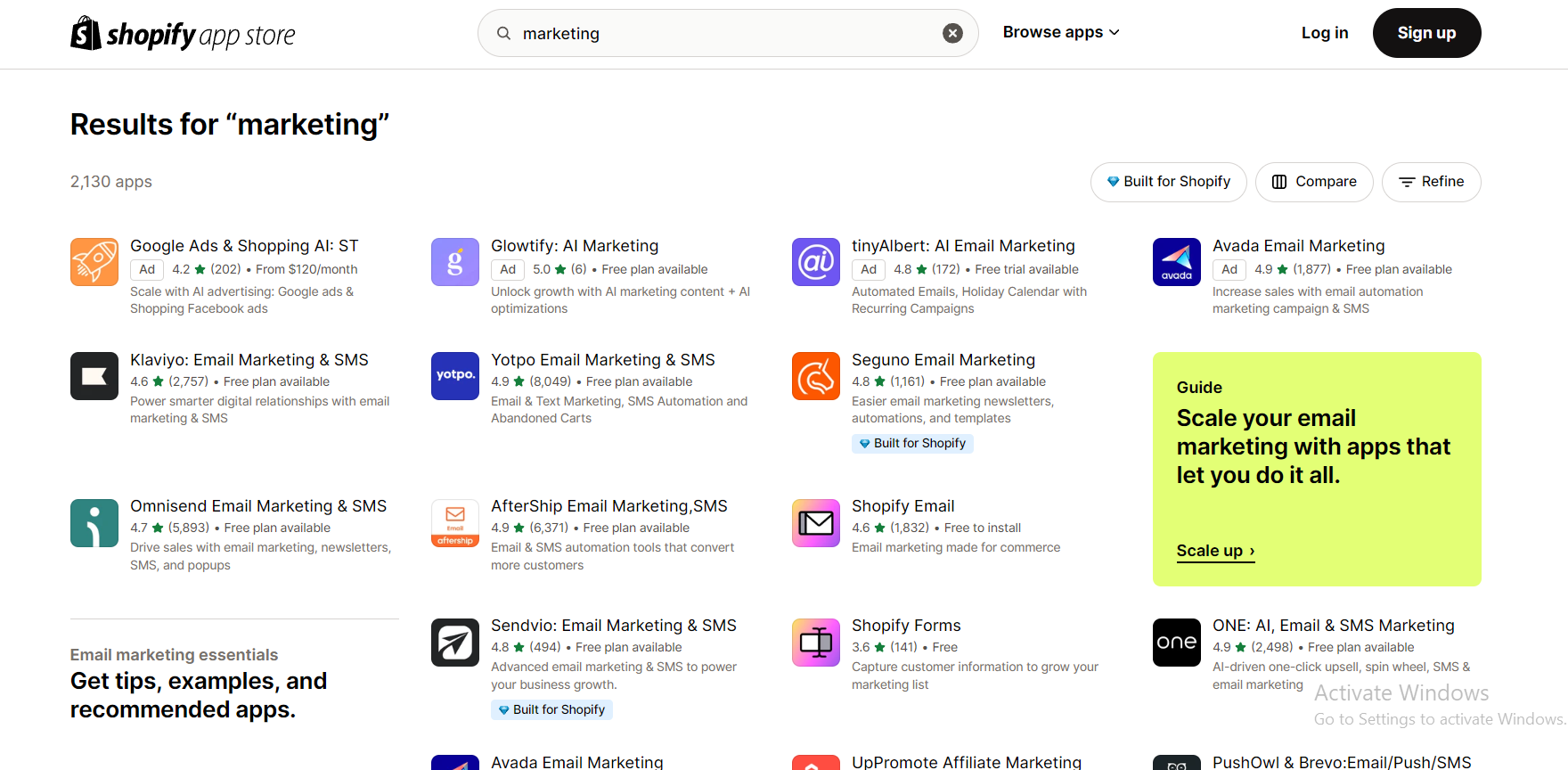
For instance, Shopify’s built-in blogging feature allows you to post articles that link to your products. If you sell fitness gear, you could write workout tips to draw readers in, and then offer them products.
Plus, Shopify offers an email marketing tool, Shopify Email, which lets you capture emails and send newsletters, helping you build long-term customer relationships.
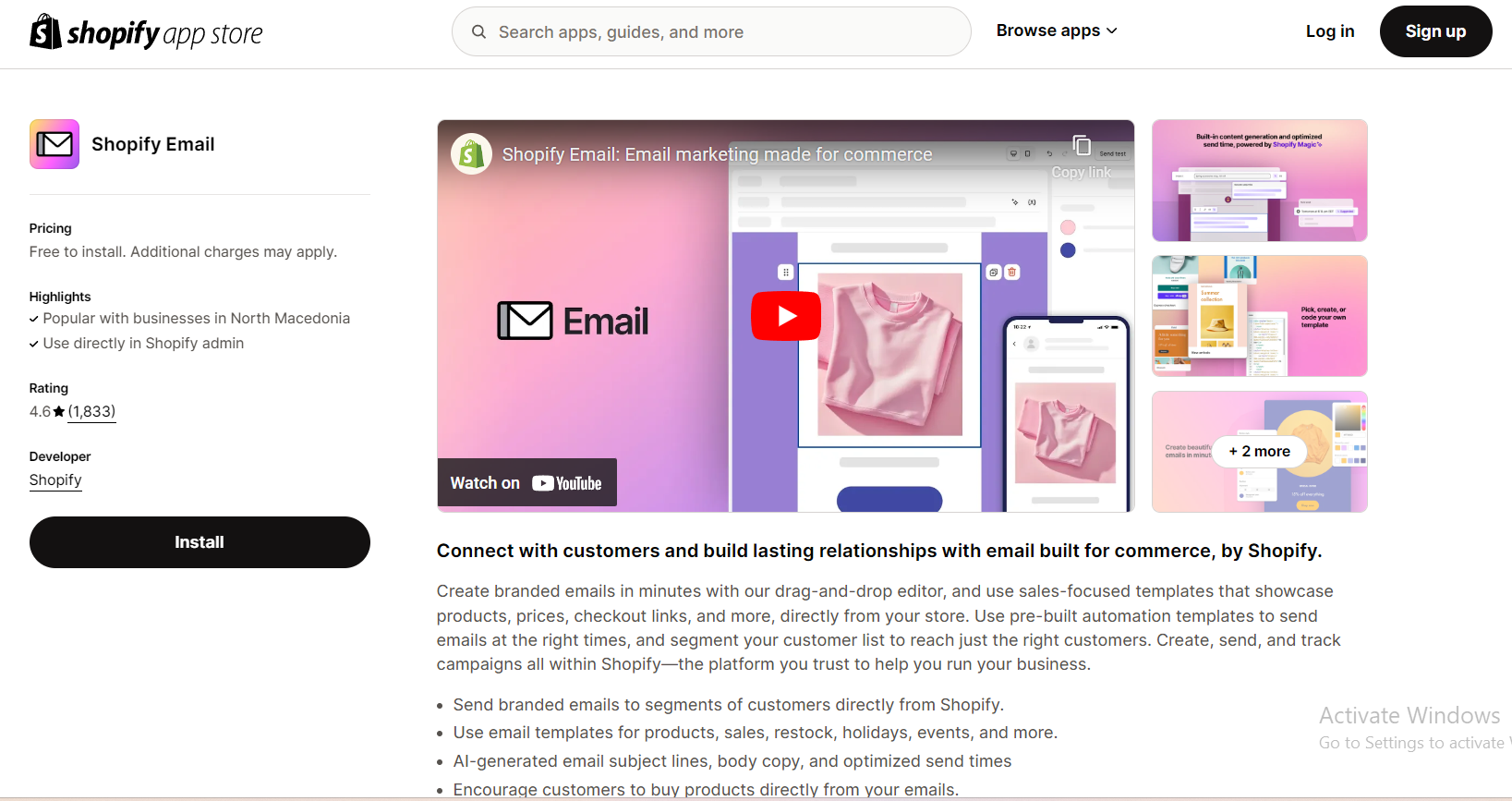
This is something Amazon sellers don’t have access to—Amazon doesn’t let you capture emails for marketing purposes.
For example, Shopify lets you create blogs directly on your store pages, which is a great way to boost your SEO and drive traffic through social media channels.
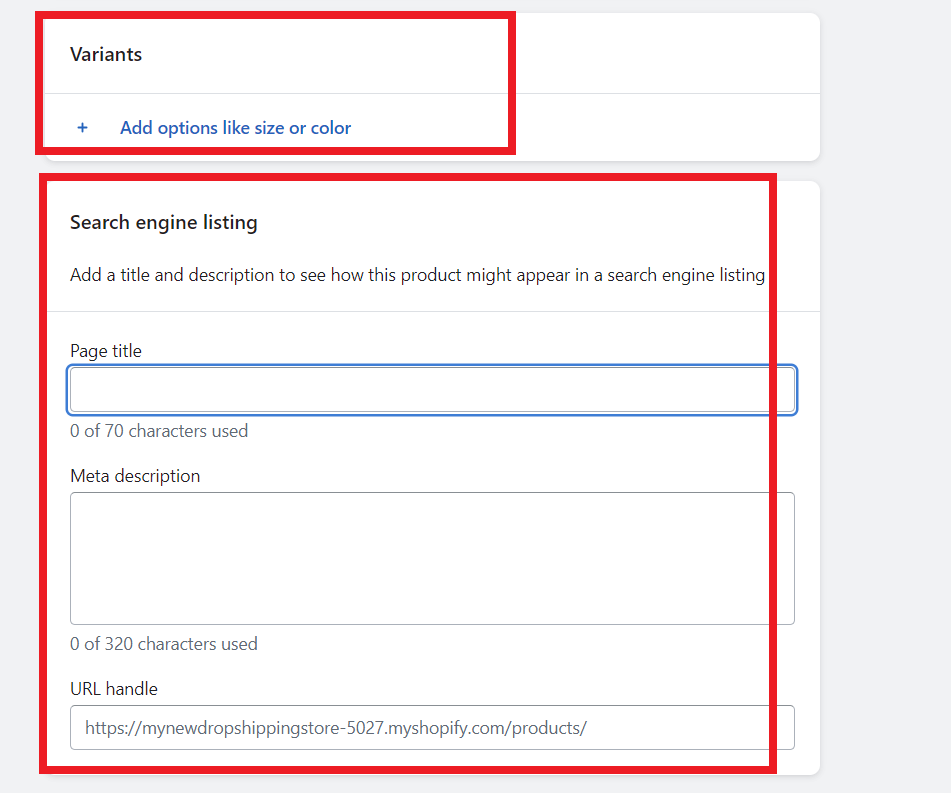
Shopify SEO
When you create a Shopify store, your primary focus should be on optimizing for Google. Since your own ecommerce website runs on your own domain, Google is the main search engine that will present your products to potential customers.
To get the most out of Shopify SEO, you’ll need to work on keyword research, optimize your store pages, and ensure your site is easy to navigate.
So, tools like Ahrefs and Semrush can help you find the right keywords to rank for.
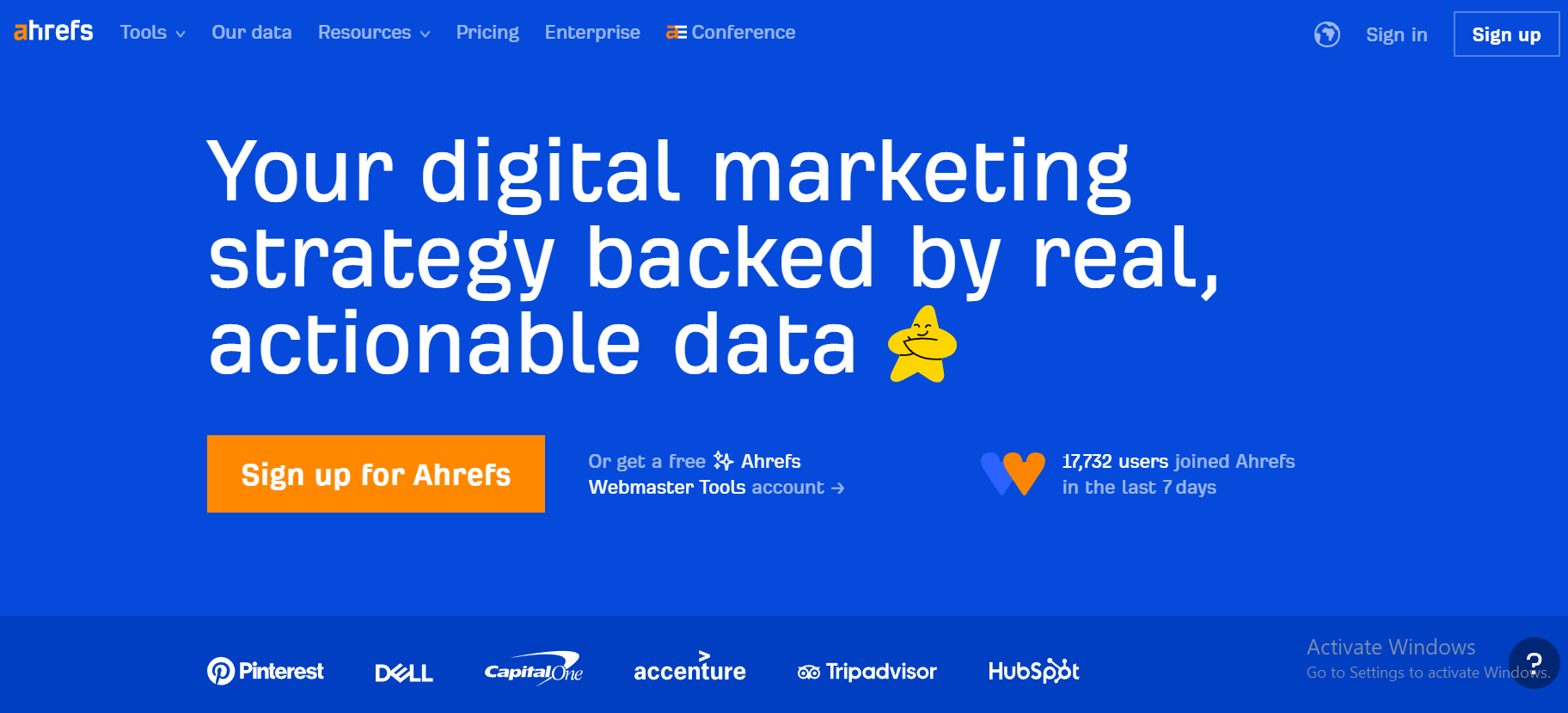
Amazon Marketing
If you’re looking for instant access to millions of online shoppers, Amazon is a clear winner in the Shopify vs Amazon debate.
Amazon’s FBA service (Fulfillment by Amazon) takes care of storing, packing, and shipping your products, letting you focus on scaling your business.
By selling on the Amazon marketplace, you tap into its massive customer base, which includes over 300 million users and billions of monthly visits.
One of the biggest perks of Amazon is its algorithm. When someone buys a product, Amazon’s system shows recommendations like “customers also viewed” or “frequently bought together,” which can lead to more views and sales for your listings.
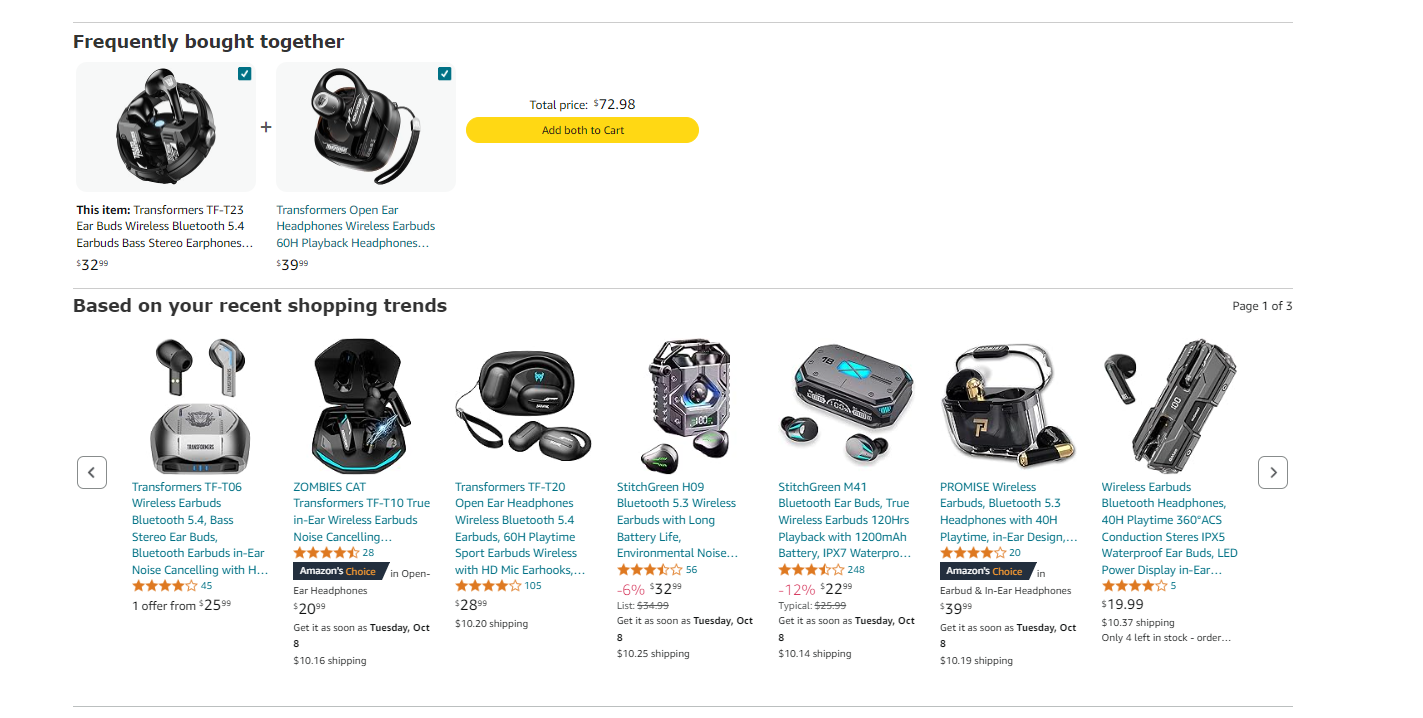
When it comes to Shopify, you need to do this cross-selling and upselling strategy on your own.
Plus, events like Amazon Prime Day and Black Friday promotions help drive traffic to your store without extra marketing efforts from you.
In my opinion, Shopify is THE BEST for SEO & Marketing. So, Amazon cannot stand out here. Sorry, Amazon.
Amazon SEO
When selling on Amazon, the focus shifts from Google to Amazon’s own search engine, often referred to as the “A9” or “A11” algorithm.
The major difference here is that on Amazon, people aren’t looking for answers—they’re searching for products and are ready to buy. This means that Amazon’s algorithm prioritizes product listings based on their likelihood to sell.
To rank well on Amazon, you need to optimize your product listings with strong keywords, high-quality images, and detailed descriptions.
While Google aims to understand complex human language, Amazon’s search engine simply looks for the best products that match the buyer’s intent
However, with Amazon SEO your store can rank on both Amazon and Google. Since Amazon storefronts are indexable by Google, you have the opportunity to appear in both search engines, giving you more chances to get traffic.
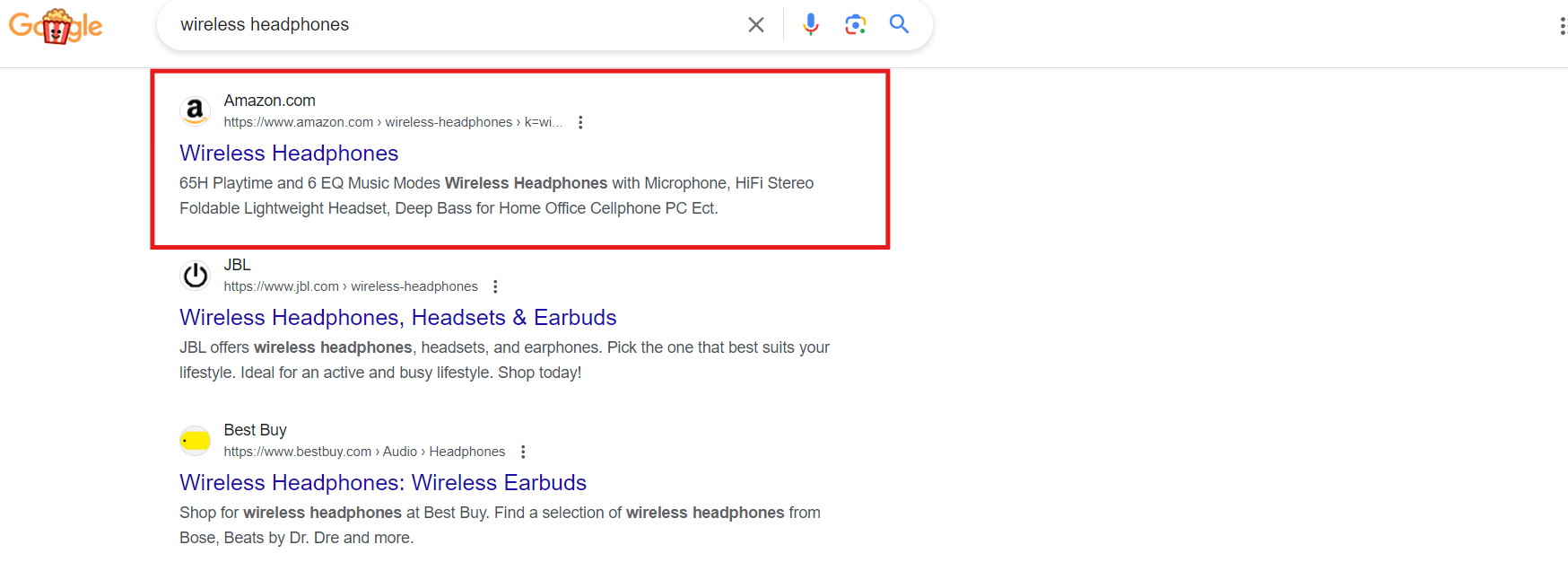
🔸 Dropshipping Capabilities
Shopify Dropshipping
Shopify is designed to make online selling easy, especially with its robust integration of dropshipping apps. Whether you’re new to eCommerce or an experienced professional seller, Shopify lets you create an own website where you don’t need to worry about inventory or shipping logistics.
A big advantage of basic Shopify plans is the access to around 600 dropshipping apps that you can connect to your store.
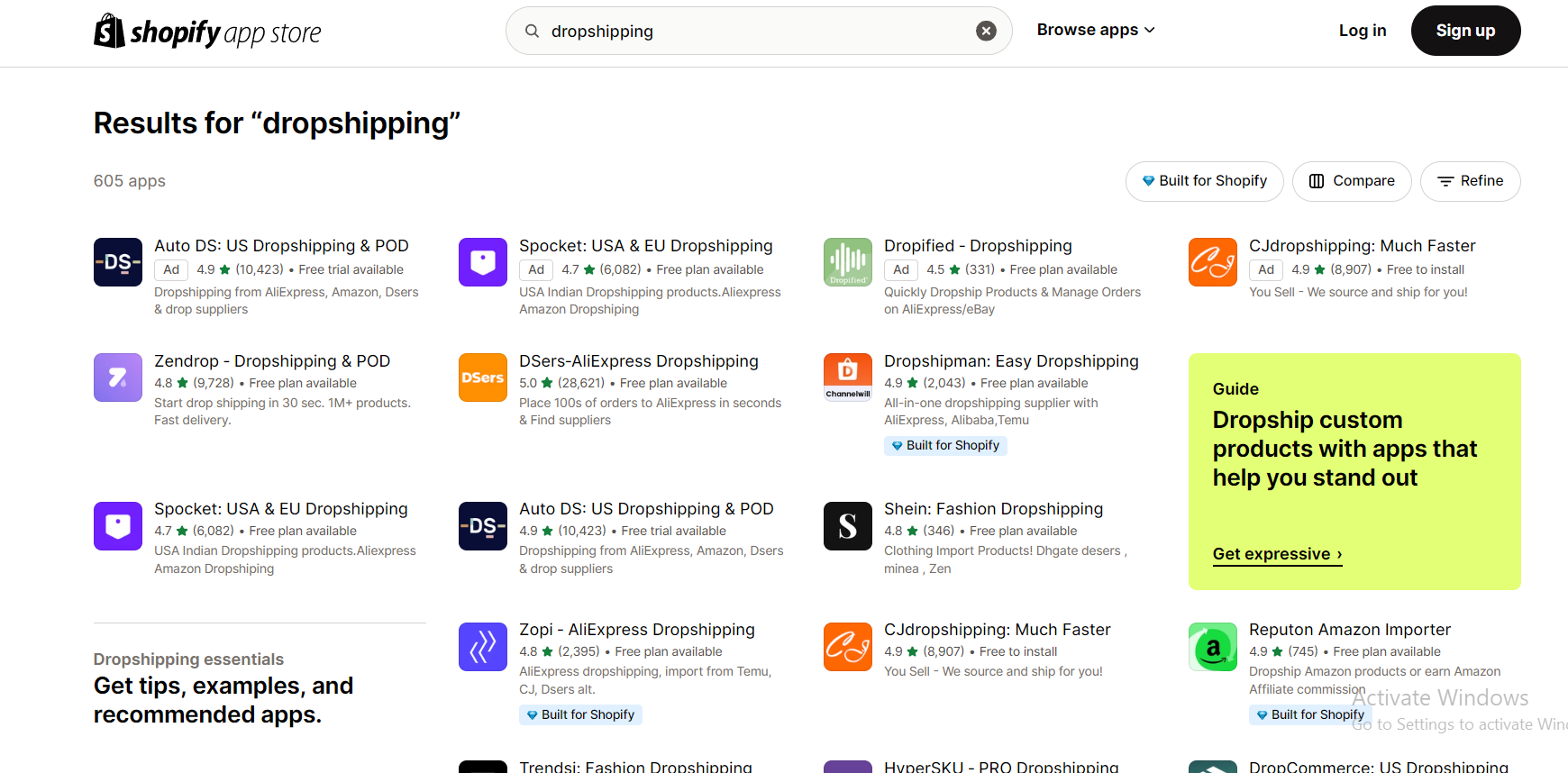
This makes it easier to find suppliers, manage products, and fulfill orders. For example, you can use AutoDS to import products and manage orders.
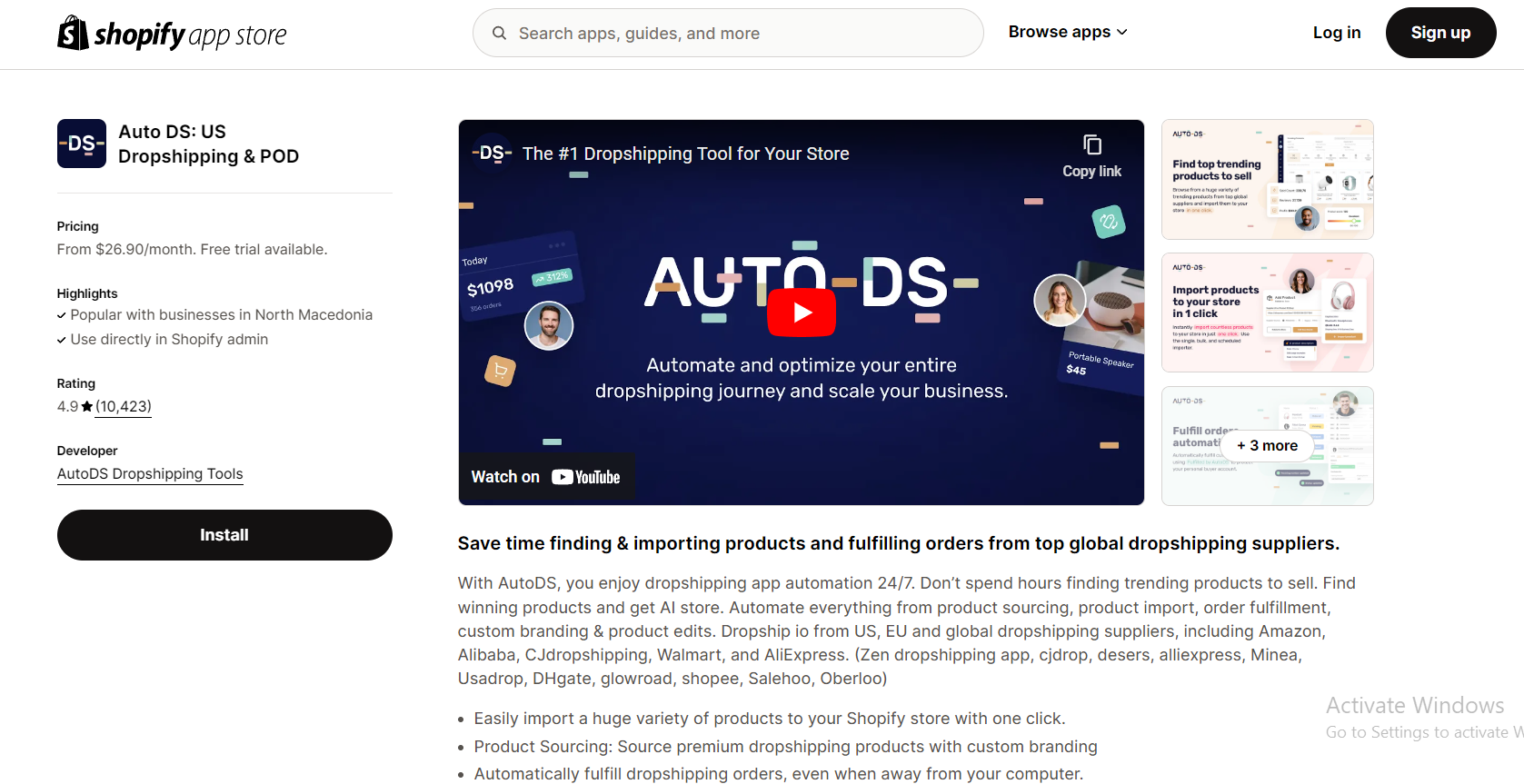
Or, you can use Spocket to find the best US or EU suppliers. Plus, you can customize your store with free and paid themes to match your branding. In other words, you have tools that can manage and automate your whole dropshipping business, whether is marketing or logistics.
Shopify is a specialized ecommerce platform that gives you full control over your store pages, including product descriptions, images, and pricing.
It also offers various payment options, including credit and debit cards, and even lets you integrate with Amazon FBA for fulfillment.
One of the biggest benefits of Shopify is that it doesn’t take a cut of your sales like Amazon does. While you’ll pay a monthly fee and some transaction fees, you keep a larger portion of your revenue compared to Amazon sellers who deal with higher selling fees.
Amazon Dropshipping
Dropshipping with Amazon is possible but comes with more restrictions. While Amazon’s FBA service handles storage and shipping, unlike Shopify, Amazon imposes specific rules for sellers.
If you want to dropship on Amazon, your suppliers must recognize you as the seller on all packing slips, invoices, and shipping labels, which can make it harder to keep operations running smoothly.
Additionally, Amazon takes a percentage of your sales (typically 10-15%) in addition to fees for using Amazon FBA. These extra costs can make it difficult to maintain high profit margins, especially if you’re working with thin margins to begin with.
For many, this makes Shopify a better option in the Shopify vs Amazon debate, especially for professional sellers who want to scale a high-volume store.
Although Amazon’s marketplace provides immediate access to millions of online shoppers, it comes with limitations.
For example, you don’t have as much control over your branding, and the Amazon seller account doesn’t allow you to build direct relationships with customers. Additionally, Amazon doesn’t give you access to customer emails for marketing purposes, while Shopify offers you full control over email marketing and customer data.
One unique benefit of Amazon is its massive fulfillment network, with fulfillment centers across the world that can ship products quickly to customers.
Amazon vs Shopify – Pros & Cons
Amazon Pros & Cons
Here are some pros of Amazon:
-
- Affiliate Marketing- even if you don’t sell directly on Amazon, you can make money through its affiliate marketing program. Many bloggers or dropshipping sellers make 30% passive income just from using this tactic.
-
- HugeTraffic- Amazon is the king of getting traffic. Whatever you sell, your product won’t be lacking any traffic. The website gets over 200 million monthly views so they are enough to help you with exposure
-
- Premium services- There are premium services Amazon can handle for you just like handling your storage, packaging & shipping it ready for you. This makes it easier for you to run your online dropshipping business.
Here are some cons of Amazon:
-
- Branding – because you are not running on your own website, it is difficult to take credit for yourself. There are also stories where Amazon destroyed businesses that either didn’t sell any of their products or those that sold lots of them.
-
- Lots of Competition – You aren’t the only one selling on Amazon, so don’t think you are just going to go there and sell from the first day. Amazon won’t let you be the greatest, so just remember that!
-
- Transaction fees – Amazon charges more from your profit than Shopify. Shopify’s maximum transaction fee is 2% per sale, while Amazon charges anywhere from 2.9% to 3.9%!
Shopify Pros & Cons
Pros of Shopify:
-
- E-Commerce Tools – Just like WordPress is great for blog websites, Shopify is great for e-commerce sites. You have different kinds of tools that are very helpful in building your online store. This makes it easier for you versus building it from scratch.
-
- Brand Promotion – unlike Amazon, Shopify allows you to promote your brand and allows you to be in full control of it. It feels as if you never used Shopify in the first place!
-
- Lots of Customization options – You have 140+ free and paid themes to choose from. Plus, they are highly customizable. You can change color, typography, add or remove landing pages, and more.
-
- Low Transaction Fees – The maximum fee Shopify will charge you is 2% of your sales. That is nearly half of what Amazon charges!
Cons of Shopify:
-
- Monthly Fees – The only con I would include about Shopify is that it has fees to it. Whatever you add to your website, the more fees you will pay.
-
- Big expenses for “No Sales” – If you don’t sell anything, your expenses can highly overtake you and potentially come to you closing down your e-commerce store!
-
- Must use Premium plan to scale up – With basic plans, Shopify won’t allow you to access any reports or special e-commerce tools to use for your online dropshipping store.
MUST-READ: Is Shopify Still The Best Platform For Dropshipping?
Can You Use Both Amazon and Shopify for Dropshipping?
Yes, you can definitely use both Amazon and Shopify for dropshipping.
In fact, by using both platforms, you can take advantage of the wide reach and credibility of Amazon, while also having the flexibility and customization options provided by Shopify.
However, it is important to note that managing inventory and order fulfillment can be more complex when using multiple platforms, so careful planning and organization are necessary to ensure a smooth dropshipping operation.
Also, as I already explained earlier, you can connect both platforms by integrating your Amazon selling account into Shopify to reach customers instantly.
Moreover, you can compare both business models by learning the differences between Dropshipping and Retail Arbitrage.
How To Start Dropshipping From Amazon To Shopify in 2024? (Step-By-Step)
1. Research and Identify Profitable Products or Niches
To start your online store, the first step is to find profitable products or niche markets.
Look for trending products with high demand and manageable competition.
Visit Amazon’s Best Seller category to explore top-selling products.
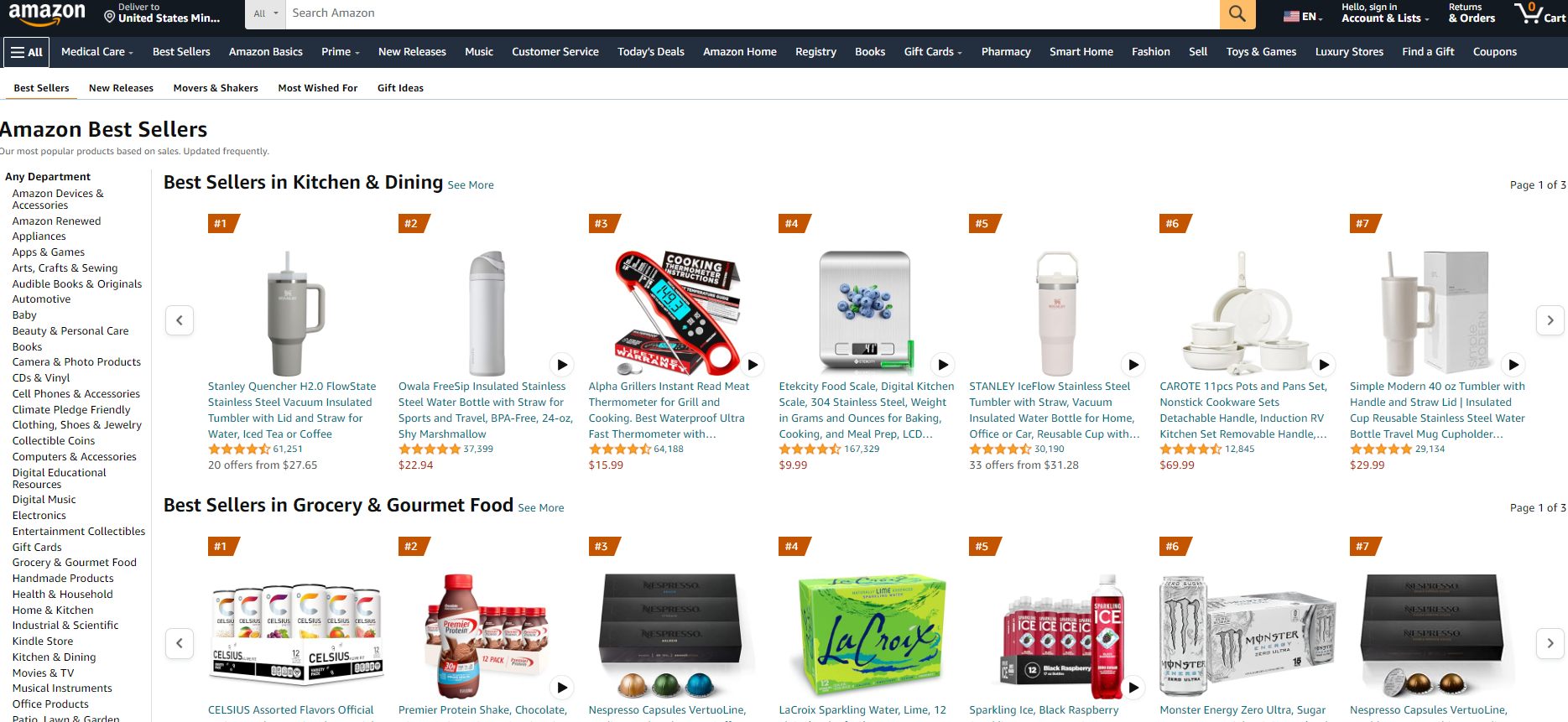
Also, you can check out Amazon Movers & Shakers for fast-growing items.
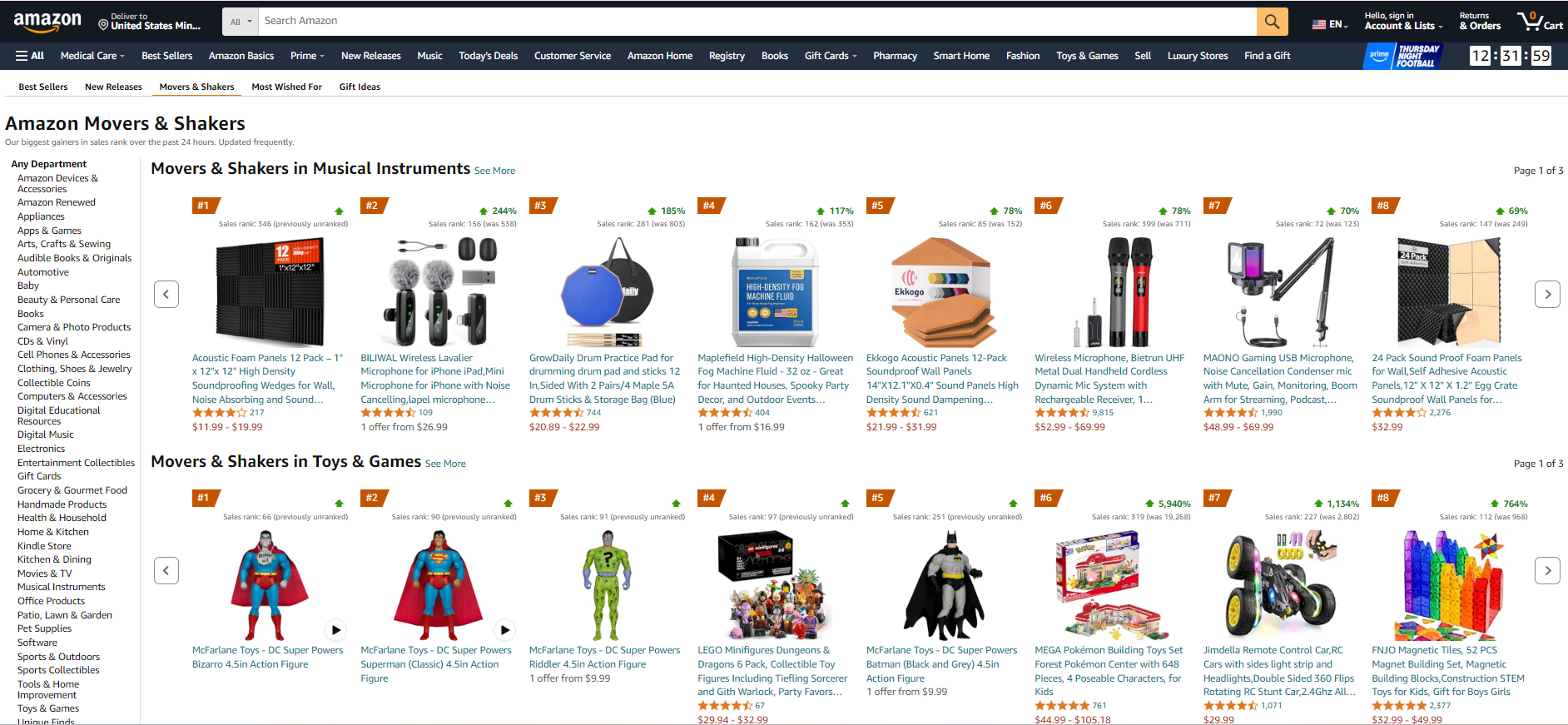
Moreover, using product research tools like Minea and market research insights can help you discover opportunities.
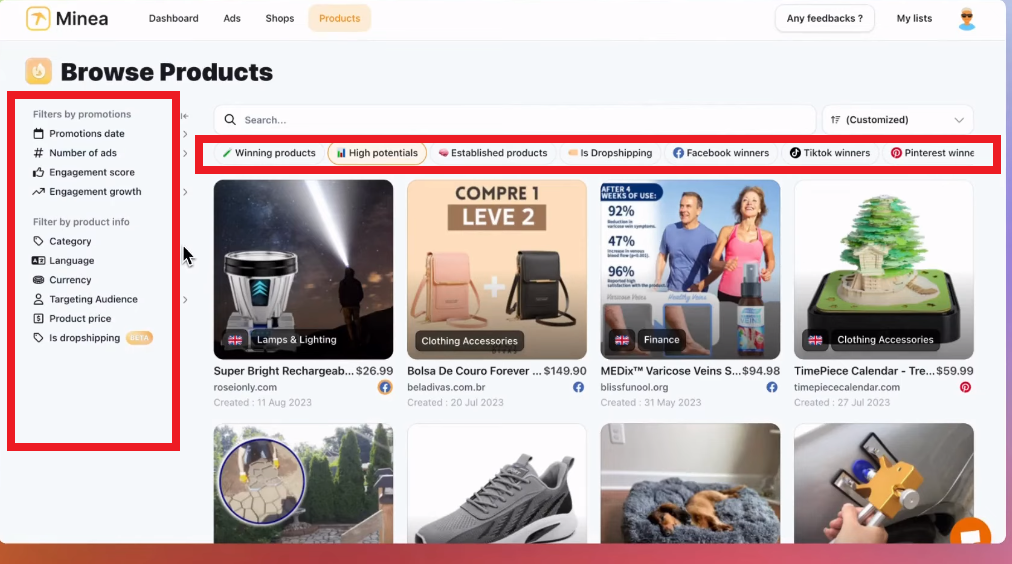
This way, you can pick the best products to sell in your own online store.
2. Find Reliable Dropship Suppliers
Firstly, you can find Amazon’s best suppliers through their search. Thus, you can simply search for the products you want to sell using their search bar.

Next, access the supplier store, and you can check their prices and other products.
Also, I strongly advise you to check their reviews and comments and see which ones are reliable.
However, what I personally do is use platforms like platforms like Dropshipping.com, AutoDS, or Zendrop to find Amazon wholesale suppliers.

These platforms allow you to compare prices, minimum orders, and shipping times to streamline your ecommerce business.
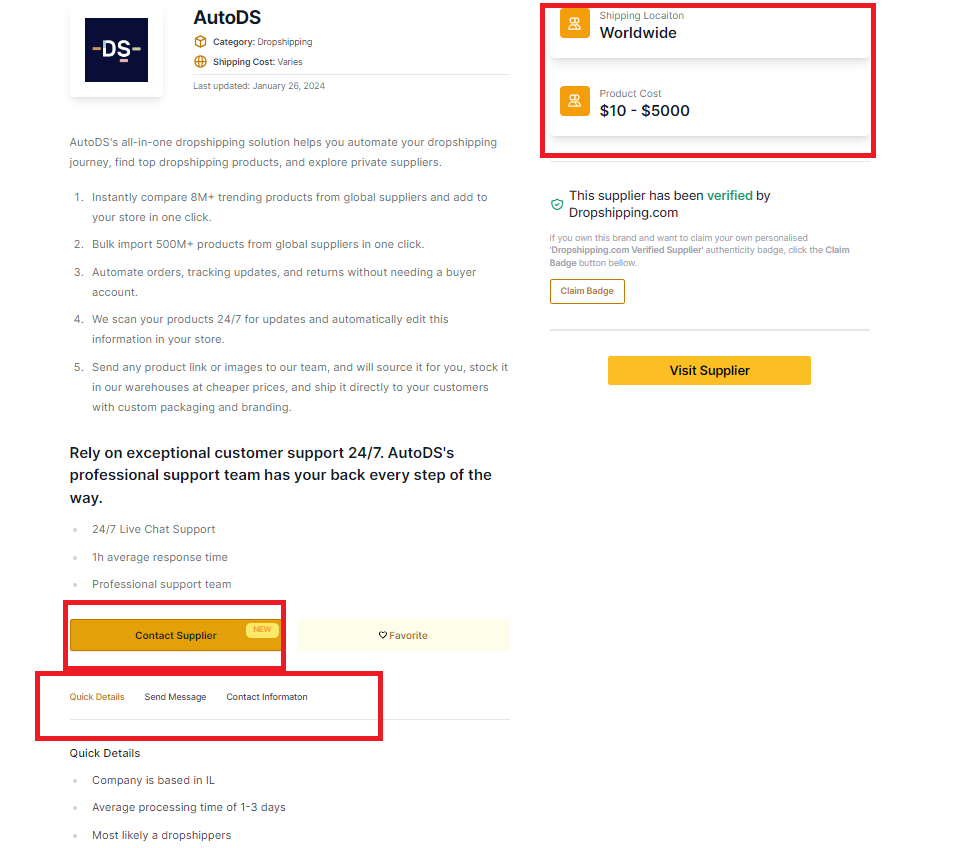
Unlike Amazon FBA, using these platforms ensures you have complete control over your ecommerce website and the suppliers you choose.
They provide details like referral fees, shipping costs, and processing times, allowing you to manage your own ecommerce business smoothly.
3. Create Your Shopify Dropshipping Store
Building your own store is the next step, and Shopify is the ideal ecommerce platform for dropshipping.
With its free and paid themes and drag-and-drop editor, you can easily design a visually appealing online store.
Shopify integrates seamlessly with third-party apps, making it simple to automate inventory and order fulfillment.
When setting up your ecommerce business, you’ll also benefit from Shopify Payments, which makes handling credit and debit card transactions hassle-free, with low transaction fees.
Shopify lets you customize your store pages, and you can find many useful apps on the Shopify App Store to enhance your store’s performance.
4. Import Amazon Products to Shopify
Next, you need an automation system to import your Amazon products to your ecommerce platform.
I recommend you use automated order management systems for efficient processing.
I’m currently using AutoDS for my dropshipping business. This platform connects seamlessly with Shopify, and you can import your Amazon products in seconds.

They will import all product details, including variations, images, titles, descriptions, and product specifics from global suppliers in one click.
This system helps you manage everything from tracking orders to updating inventory on your standalone online store.
Unlike selling directly on Amazon FBA, this gives you full control over your online business and product listings.
5. Implement Marketing Strategies
To drive traffic to your ecommerce website, use search engine optimization (SEO), social media marketing, email marketing, and online advertising.
Moreover, you can increase sales by offering discount codes, using cross-selling and up-selling techniques, and running referral programs.
Also, incorporate video marketing to showcase your products and highlight their features, and consider using tools available in the Shopify App Store to automate your marketing efforts.
Adding these strategies can attract more online shoppers to your store.
6. Streamline Customer Support
Providing excellent customer support is key to a successful ecommerce business. You’ll want to offer 24/7 support through multiple channels like email, social media, and live chat.
So, using tools like Tidio will allow you to automate responses and ensure timely communication with your customers.
With features that integrate with Instagram and Facebook Messenger, and the ability to sync your emails, Tidio helps simplify your customer service experience. Having strong customer support can build trust and loyalty in your online store.
By following these steps, you’ll be well on your way to building a successful ecommerce platform for dropshipping from Amazon to Shopify in 2024.
Amazon Vs Shopify Real-Life Success Stories & Expert Advice
Teen Entrepreneur Alex Philip: How a Young Dropshipper Built a Multi-Million Dollar Empire
Alex Philip’s entrepreneurial journey started at just 11 years old, selling Pokémon toys on Amazon. By 15, he had earned over $2 million through sourcing products from Alibaba and selling them on Shopify.
In 2017, he discovered dropshipping and focused on building a Shopify store, sourcing products from Chinese suppliers. Instead of prioritizing his store’s appearance, he concentrated on marketing strategies, especially Facebook ads, and boosting conversion rates with guidance from mentor Julian Hall.
Alex also spends time researching trending products on social media before school, which helps him find profitable items. He highlights the importance of learning over making money, advising young dropshippers to embrace mistakes and take action. Hiring a virtual assistant, according to Alex, played a key role in helping him manage his business as it grew.
Now, Alex continues to drive traffic to his dropshipping store using strategic ad campaigns while constantly improving his processes to stay ahead of the competition.
From 9-to-5 to Millionaire: How Mina Elias Turned Amazon FBA Into a Multi-Million Dollar Success
Mina Elias’ journey to success with Amazon FBA began when he felt trapped in his 9-to-5 job, despite having earned a degree in chemical engineering.
Feeling unfulfilled, he realized he needed a change. During a 2018 vacation in Egypt, his father suggested he create his own supplements after noticing Mina buying various supplements for his MMA training. This idea sparked his venture into Amazon FBA.
Mina researched how to create his own electrolyte supplement, developed the product, and began selling it locally. Despite facing initial rejections from supplement stores and MMA events, Mina kept pushing.
It was at an MMA event in November 2018 that he told attendees his product would soon be on Amazon, even though it wasn’t yet ready. This drove him to dive deep into the Amazon FBA world.
After months of research and trial, Mina finally launched his product on Amazon in November 2018. He mastered the complexities of Amazon’s platform, learning how to handle certificates, manufacturing, and shipping.
One crucial element was understanding Amazon’s PPC (pay-per-click) advertising, which significantly boosted his sales. Through strategic ad campaigns and consistent customer reviews, Mina saw his sales skyrocket.
By early 2019, Mina was generating thousands in profit. However, when he lost his job in April, he took the risk to go all-in with Amazon FBA.
He spent the next few months in Egypt to save money, focusing entirely on growing his business. His review strategy and attention to Amazon’s PPC system led to massive growth, pushing his business to over $38,000 in monthly sales.
As his Amazon brand stabilized, Mina also started an Amazon advertising agency, Trivium, helping other brands navigate and succeed on Amazon.
Today, Mina continues to run his supplement brand while expanding his advertising agency, proving that with hard work, persistence, and constant learning, success through Amazon FBA is achievable.
Alex Ikonn & Mimi: Building a Seven-Figure Empire with Luxy Hair
Alex Ikonn and Mimi built a seven-figure Shopify store through Luxy Hair, selling hair extensions. They utilized key Shopify apps like Klaviyo and Refersion to streamline daily activities.
Their success on platforms like YouTube, Instagram, and Pinterest helped them cultivate a strong online presence, driving traffic to their online store.
Moreover, by leveraging Shopify’s ecommerce platform, they were able to minimize transaction fees while focusing on social media marketing.
They credit their success to creating value and solving customer problems, which has built trust and boosted sales. They highlight the importance of owning an online business and using Shopify vs Amazon to their advantage.
Andreas & Alexander: Achieving $10 Million in Pet Dropshipping Sales
Andreas and Alexander scaled their Shopify store to $10 million in sales by focusing on the pet niche. Through Shopify’s ecommerce tools and strategic social media marketing, they built a loyal customer base.
Thus, they used Facebook ads and Google Trends to target and engage 2.5 million pet owners, driving significant revenue. Their success also stemmed from understanding the impact of ecommerce platforms and testing products before the launch.
So, by using third-party apps and Shopify’s store pages, Andreas and Alexander proved that Shopify could be an effective tool for growing a standalone online store in the pet industry.
Amazon vs Shopify – Who Wins?
So it comes down to Shopify vs Amazon, who is the real winner? Is it the autonomy of Shopify, or is it the already-made Amazon? Here is your answer:
If I look at which platform is better to have a dropshipping store, then it is definitely Shopify. Since Shopify gives you flexibility and allows you to run your store however and whichever way you want, this lets you run your online e-commerce store without any distractions. Plus, you don’t have to worry about brand awareness, promotions, design, flexibility, autonomy, etc.
And of course think about the minimum budget, to start your dropshipping journey. I covered this topic in-depth here.
On the other side, I also have online sellers who don’t want to take the liability of taking care of everything by themselves. They prefer to choose a platform that is ready for them and doesn’t waste their time and energy creating an online store. In this case, you want to choose Amazon.
The answer all comes down to what you want. What kind of seller are you? What is your goal? Once you know this, then you can find out who wins for your case.
So, before making a decision, make sure to create a dropshipping business plan.
IDEA #1: Spocket Dropshipping: The Ultimate Guide to Dropshipping With Spocket in the EU & US
IDEA #2: Wish Dropshipping: Everything You Need To Know As A Beginner.




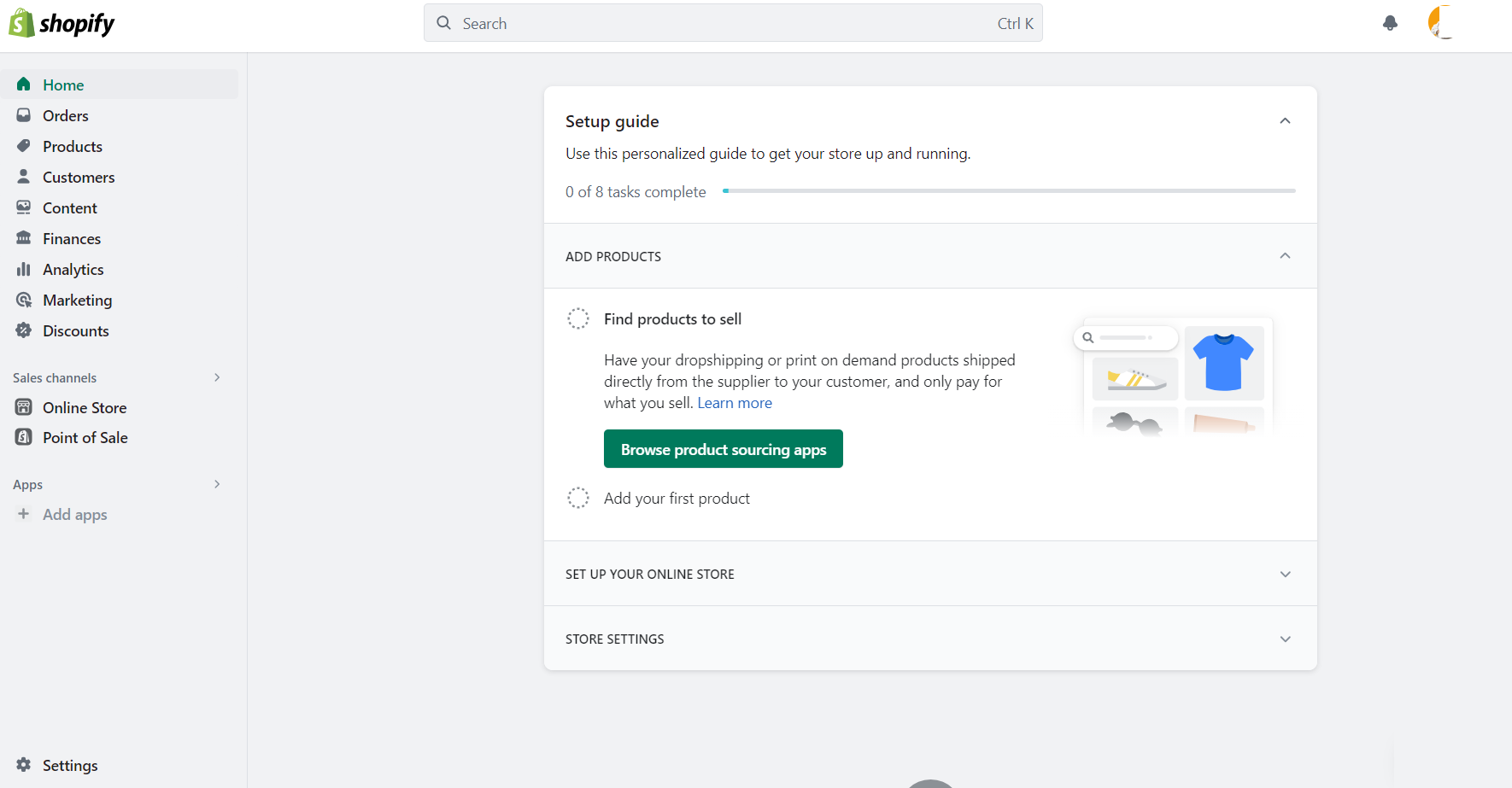
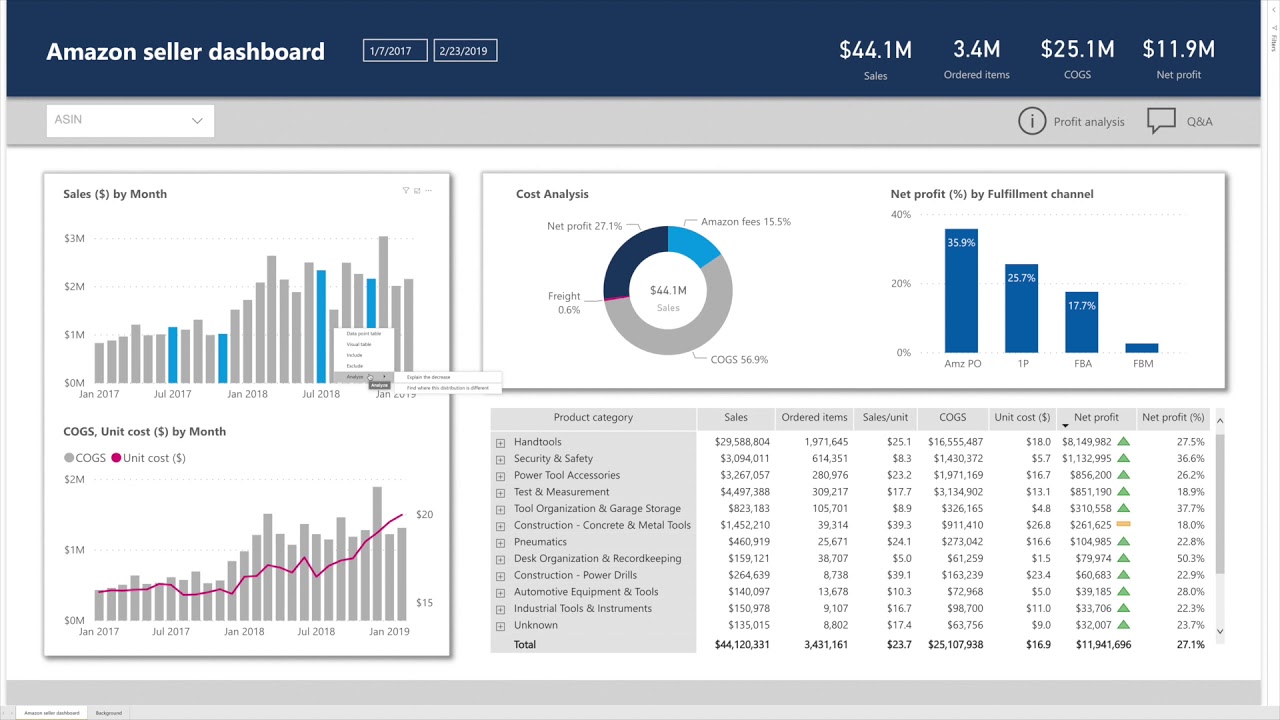

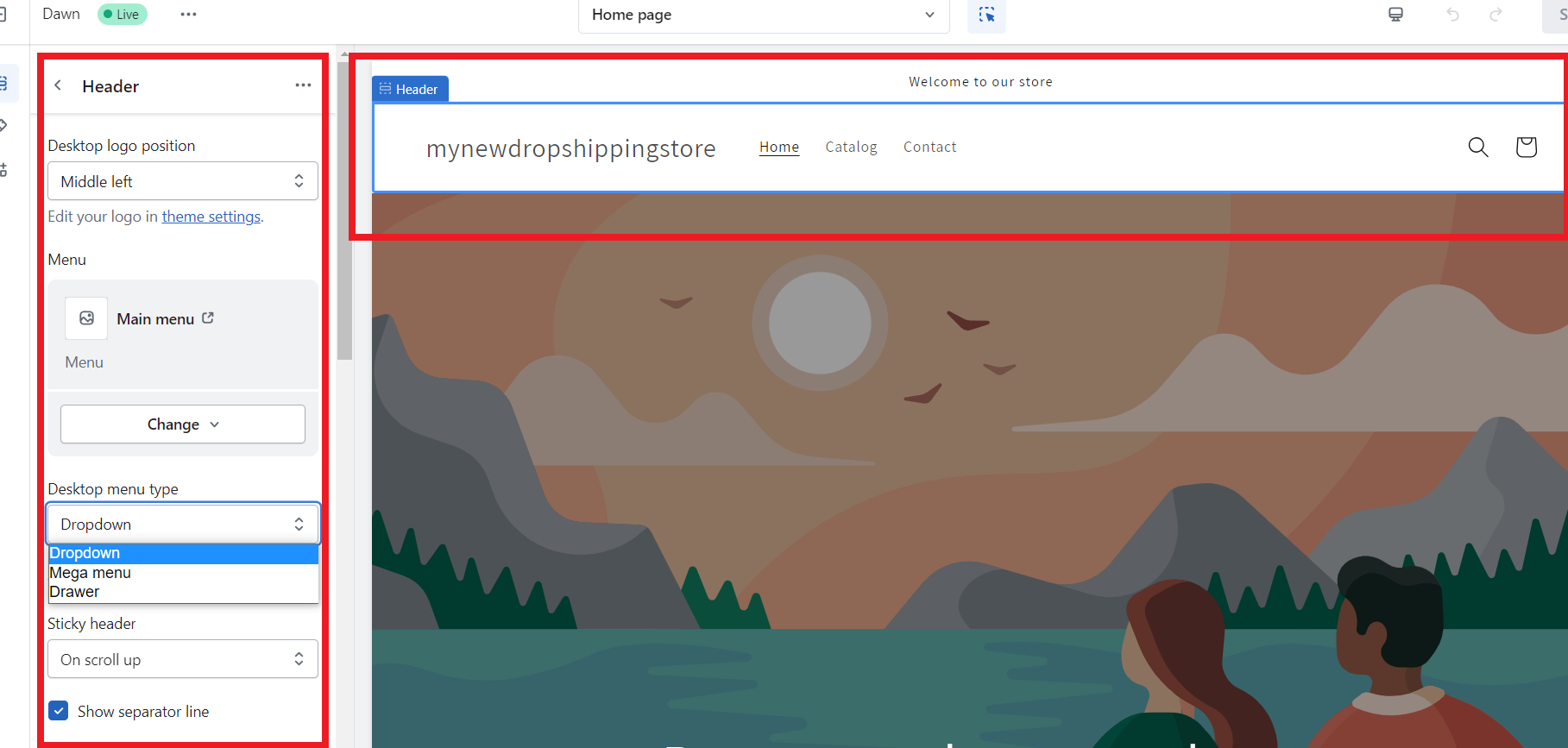




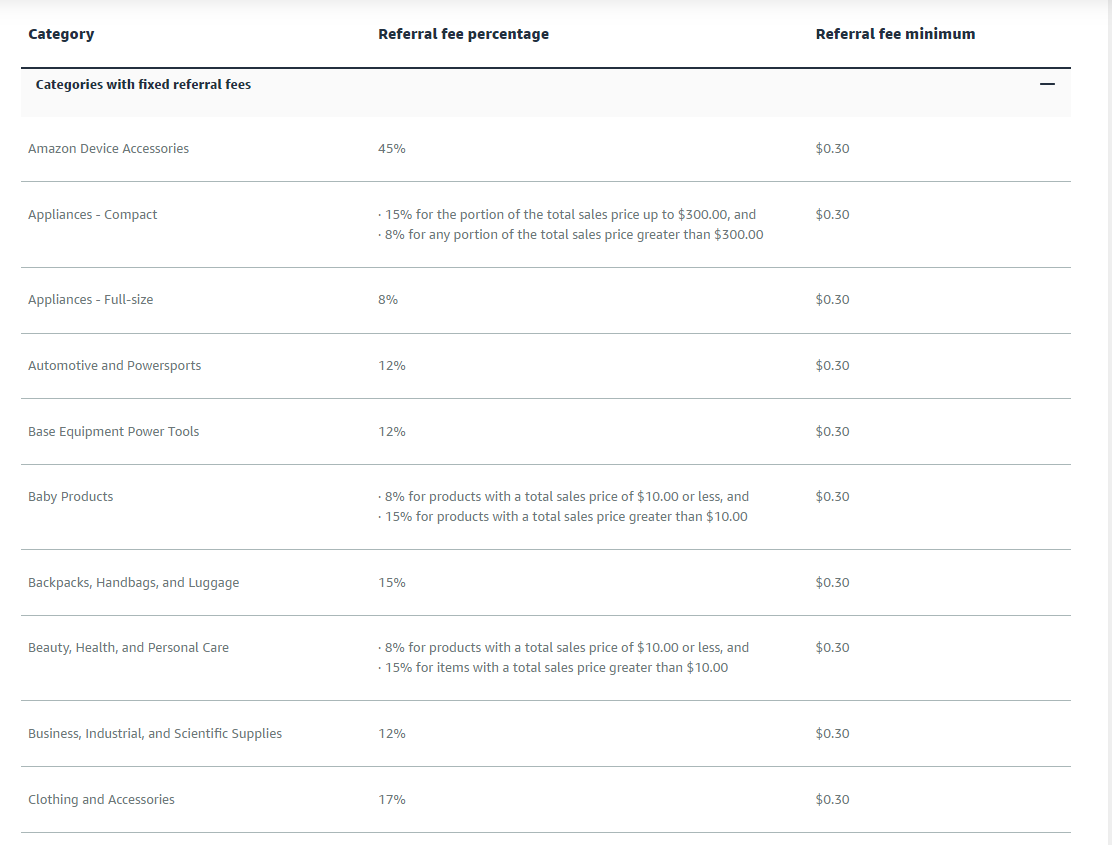
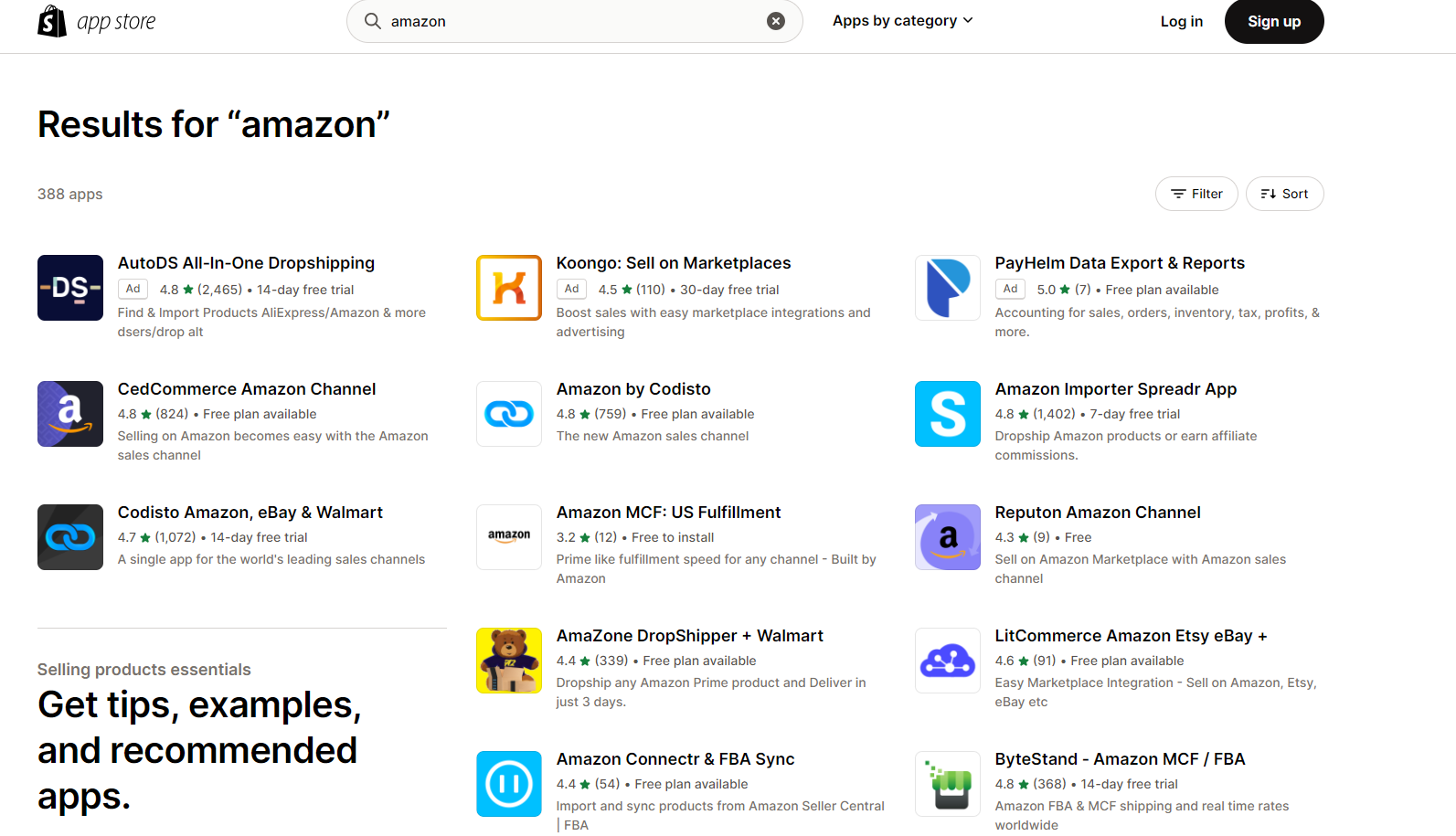
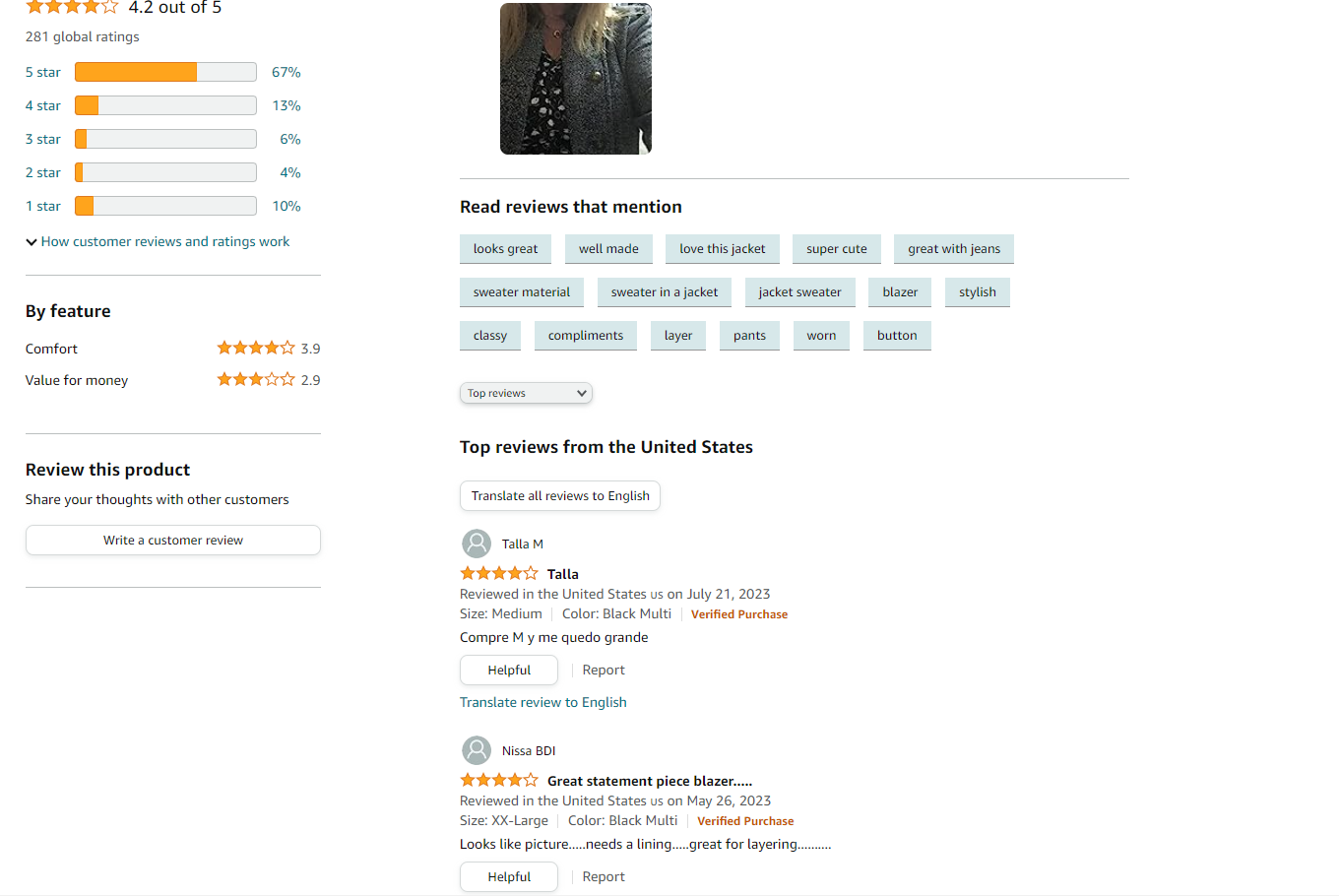
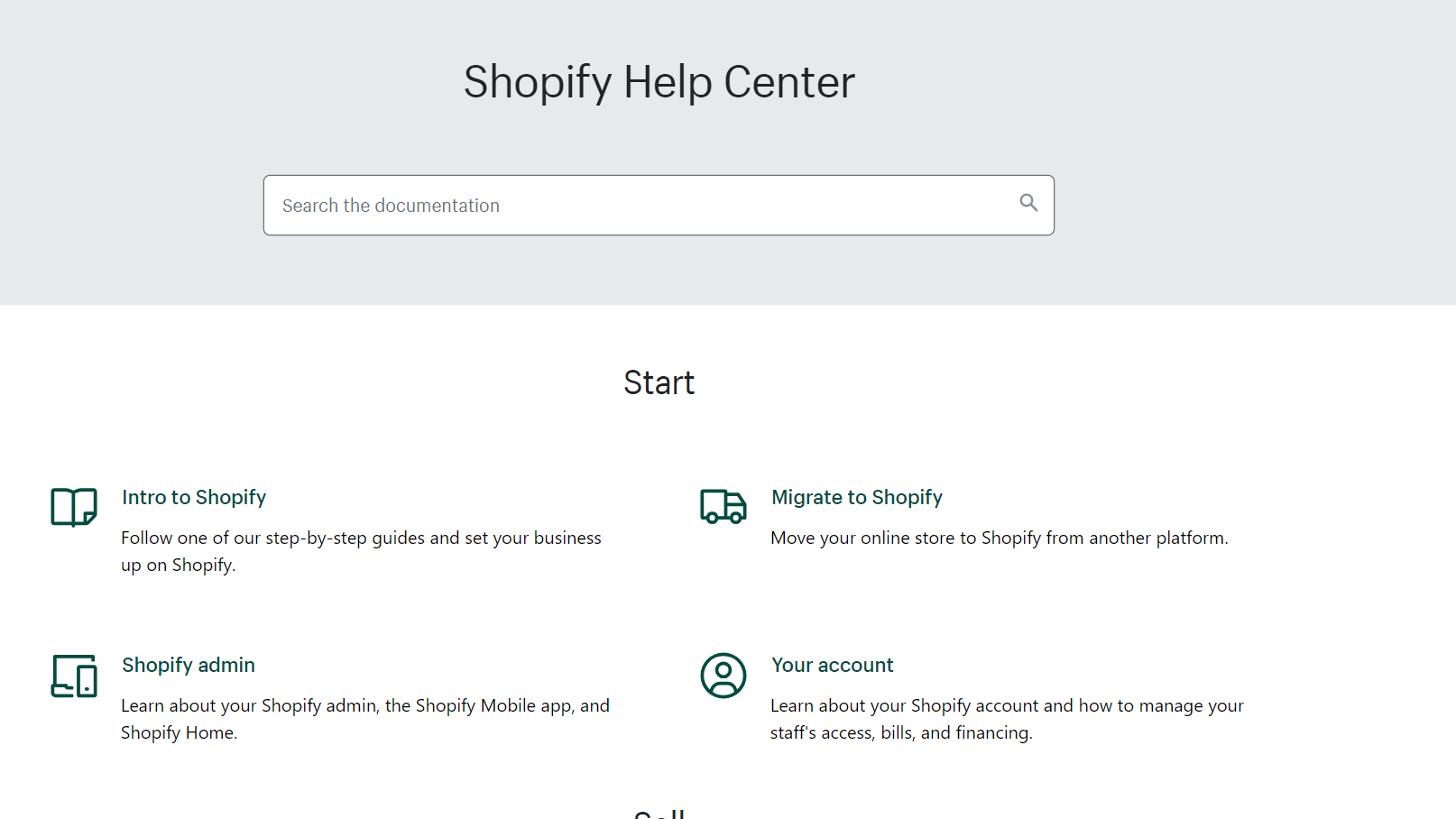

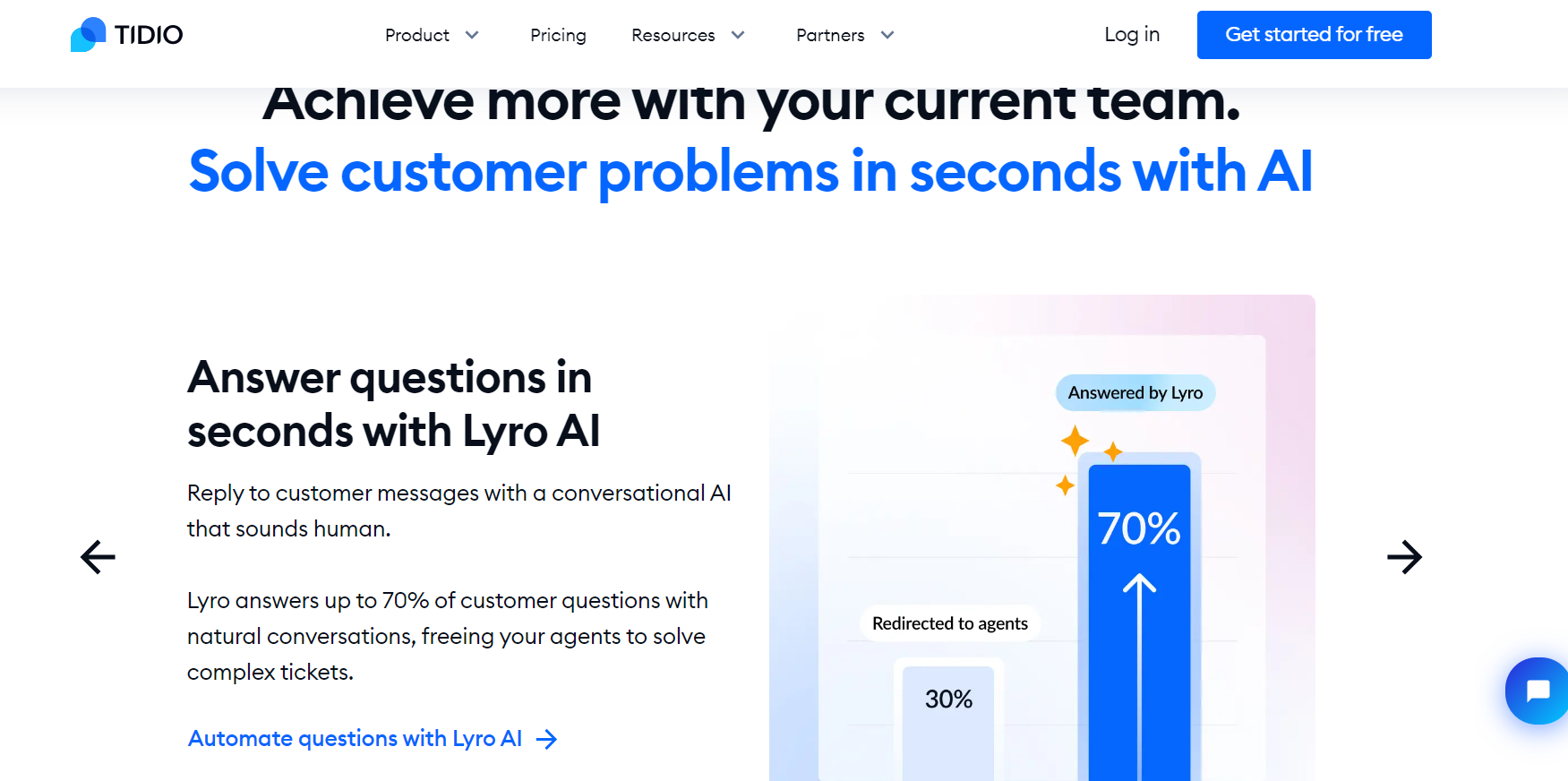











![The Top 21 3PL Companies Compared [2024 List & Guide]](https://images.weserv.nl/?url=https://prod-dropshipping-s3.s3.fr-par.scw.cloud/2024/03/Frame-3922469.jpg&w=420&q=90&output=webp)